

Compact Muon Solenoid
LHC, CERN
| CMS-PAS-EXO-21-002 | ||
| Inclusive nonresonant multilepton probes of new phenomena at $\sqrt{s}= $ 13 TeV | ||
| CMS Collaboration | ||
| August 2021 | ||
| Abstract: An inclusive search for nonresonant signatures of beyond the standard model phenomena in events with three or more charged leptons, including hadronic decays of tau leptons, is presented. The analysis is based on a data sample corresponding to an integrated luminosity of 138 fb$^{-1}$ of proton-proton collisions at $\sqrt{s}= $ 13 TeV, collected with the CMS detector at the LHC in 2016-2018. Events are categorized based on the charge and flavor multiplicities of the leptons, the multiplicity of b tagged jets, and various kinematic variables. Three scenarios of physics beyond the standard model are probed, viz. the pair production of type-III seesaw heavy fermions with arbitrary couplings to leptons of any flavor, vector-like leptons with couplings to tau leptons, and third generation leptoquarks with flavor-diagonal or cross-generational couplings involving top quarks and charged leptons. Optimal separation between signal and standard model background processes is achieved by the use of signal-specific boosted decision trees. No significant deviations from the background expectations are observed. Lower limits are set at 95% confidence level on the masses of type-III seesaw heavy fermions at 890 GeV for any branching fraction combination to standard model leptons. Scalar leptoquarks decaying exclusively to a top quark and a lepton of any flavor are excluded for masses below 1120 GeV. Doublet and singlet vector-like tau lepton extensions of standard model are excluded for masses below 1045 GeV and in mass range of 125-170 GeV, respectively. Detailed results are also presented to facilitate alternative theoretical interpretations. | ||
|
Links:
CDS record (PDF) ;
CADI line (restricted) ;
These preliminary results are superseded in this paper, Submitted to PRD. The superseded preliminary plots can be found here. |
||
| Figures & Tables | Summary | Additional Figures | References | CMS Publications |
|---|
| Figures | |

png pdf |
Figure 1:
Example processes illustrating production and decay of type-III seesaw heavy fermion pairs at the LHC that result in multilepton final states. |

png pdf |
Figure 1-a:
Example process illustrating production and decay of type-III seesaw heavy fermion pairs at the LHC that result in multilepton final states. |
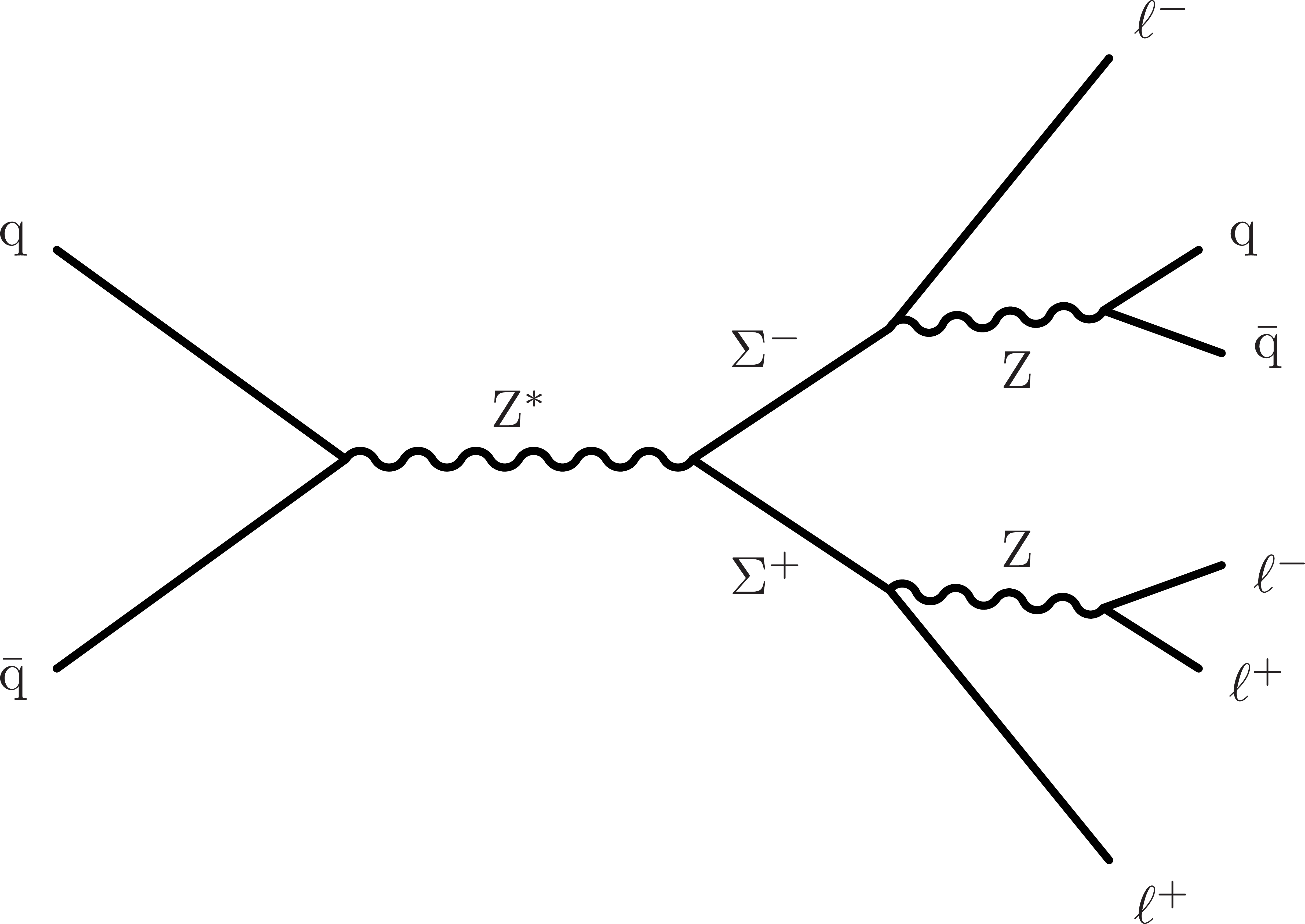
png pdf |
Figure 1-b:
Example process illustrating production and decay of type-III seesaw heavy fermion pairs at the LHC that result in multilepton final states. |

png pdf |
Figure 2:
Example processes illustrating production and decay of doublet (left) and singlet (right) vector-like tau lepton pairs at the LHC that result in multilepton final states. |

png pdf |
Figure 2-a:
Example process illustrating production and decay of doublet vector-like tau lepton pairs at the LHC that result in multilepton final states. |

png pdf |
Figure 2-b:
Example process illustrating production and decay of singlet vector-like tau lepton pairs at the LHC that result in multilepton final states. |

png pdf |
Figure 3:
Example processes illustrating the production and decay of leptoquark pairs in pp collisions at the LHC that result in multilepton final states. |

png pdf |
Figure 3-a:
Example process illustrating the production and decay of leptoquark pairs in pp collisions at the LHC that result in multilepton final states. |
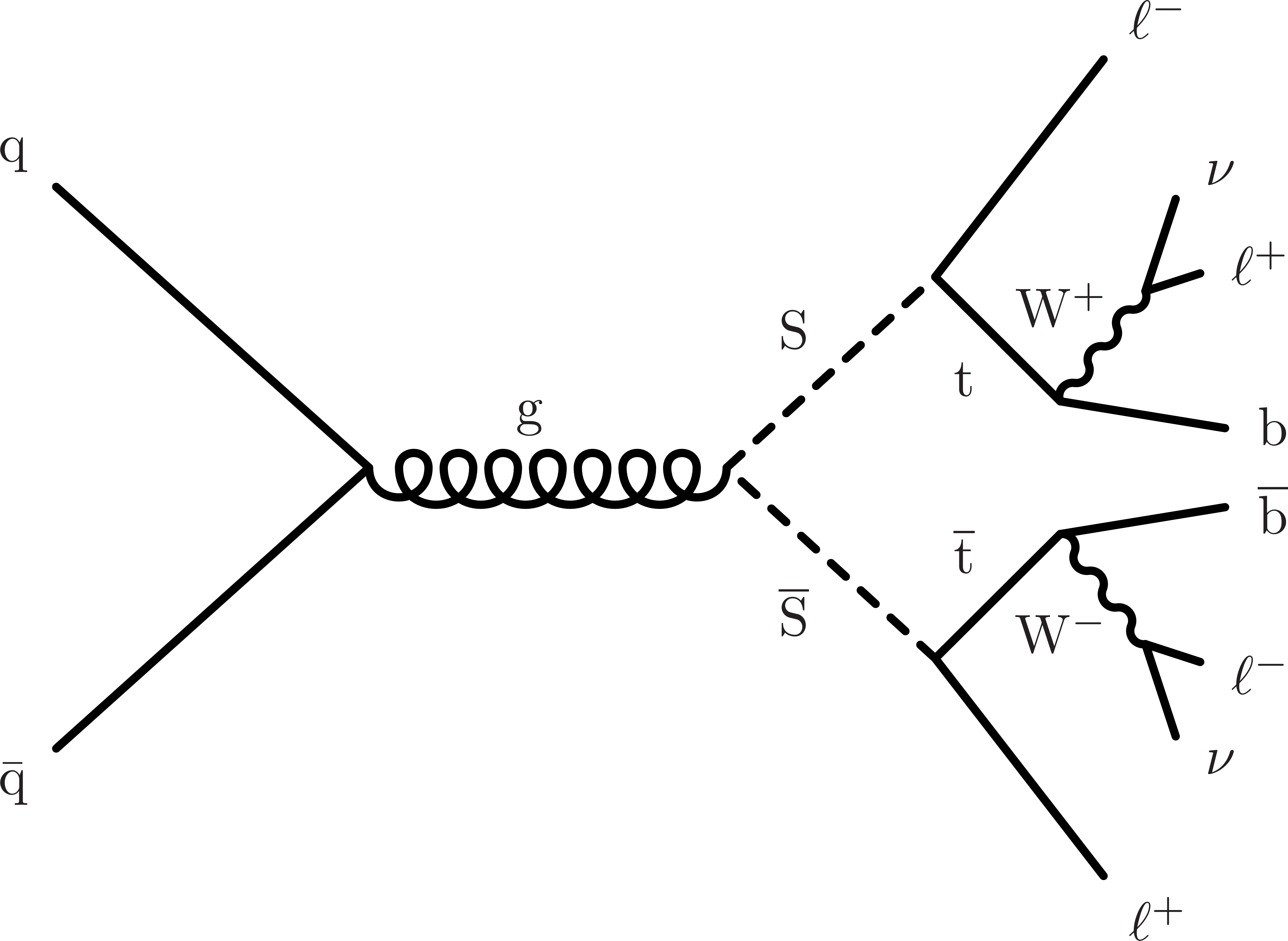
png pdf |
Figure 3-b:
Example process illustrating the production and decay of leptoquark pairs in pp collisions at the LHC that result in multilepton final states. |
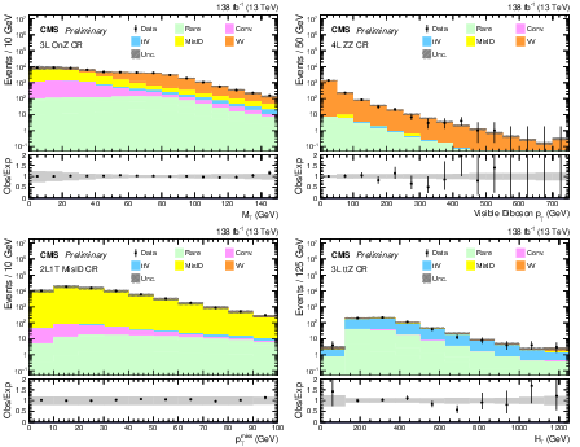
png pdf |
Figure 4:
The distributions of $ {M_{\rm T}}$ in 3L OnZ CR, visible diboson $ {p_{\mathrm {T}}} $ in 4L ZZ CR, ${{p_{\mathrm {T}}} ^\text {miss}}$ in 2L1T MisID CR, and $ {H_{\mathrm {T}}} $ in 3L ttZ CR events. The rightmost bin contains the overflow events in each distribution. The gray bands represent the sum of statistical and systematic uncertainties on the SM background predictions. |

png pdf |
Figure 4-a:
The distribution of $ {M_{\rm T}}$ in 3L OnZ CR events. The rightmost bin contains the overflow events in each distribution. The gray bands represent the sum of statistical and systematic uncertainties on the SM background predictions. |
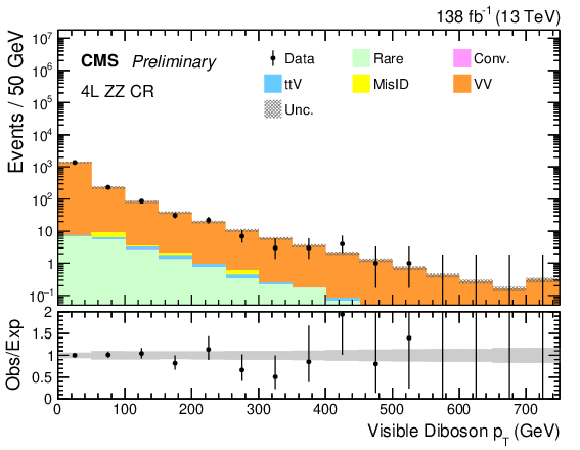
png pdf |
Figure 4-b:
The distribution of visible diboson $ {p_{\mathrm {T}}} $ in 4L ZZ CR events. The rightmost bin contains the overflow events in each distribution. The gray bands represent the sum of statistical and systematic uncertainties on the SM background predictions. |

png pdf |
Figure 4-c:
The distribution of ${{p_{\mathrm {T}}} ^\text {miss}}$ in 2L1T MisID CR events. The rightmost bin contains the overflow events in each distribution. The gray bands represent the sum of statistical and systematic uncertainties on the SM background predictions. |

png pdf |
Figure 4-d:
The distribution of $ {H_{\mathrm {T}}} $ in 3L ttZ CR events. The rightmost bin contains the overflow events in each distribution. The gray bands represent the sum of statistical and systematic uncertainties on the SM background predictions. |

png pdf |
Figure 5:
Distributions of BDT score from the SS-M $\mathcal {B}_{\mathrm{e}}=\mathcal {B}_{\mu}=\mathcal {B}_{\tau}$ BDT are shown for the combined 3L OnZ, 3L Z$\gamma$, and 2L1T MisID CRs denoted as 3L+2L1T CR (left), and the 4L ZZ CR (right). The gray bands represent the sum of statistical and systematic uncertainties on the SM background predictions. |

png pdf |
Figure 5-a:
The distribution of the BDT score from the SS-M $\mathcal {B}_{\mathrm{e}}=\mathcal {B}_{\mu}=\mathcal {B}_{\tau}$ BDT is shown for the combined 3L OnZ, 3L Z$\gamma$, and 2L1T MisID CRs denoted as 3L+2L1T CR. The gray bands represent the sum of statistical and systematic uncertainties on the SM background predictions. |
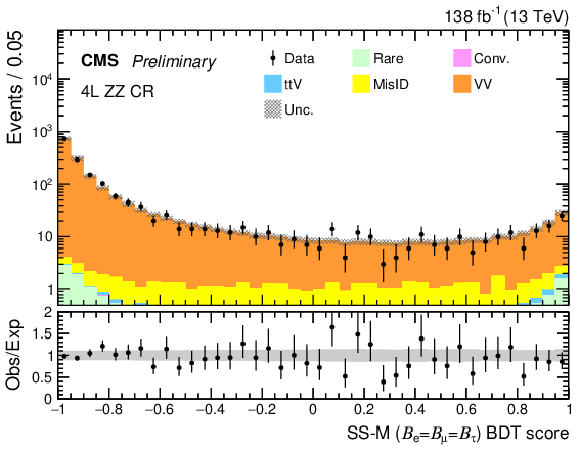
png pdf |
Figure 5-b:
The distribution of the BDT score from the SS-M $\mathcal {B}_{\mathrm{e}}=\mathcal {B}_{\mu}=\mathcal {B}_{\tau}$ BDT is shown for the 4L ZZ CR. The gray bands represent the sum of statistical and systematic uncertainties on the SM background predictions. |
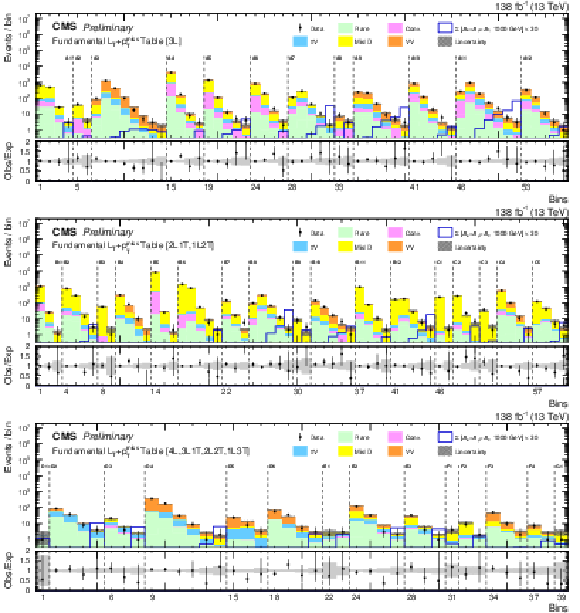
png pdf |
Figure 6:
SR distributions of the fundamental $ {L_{\rm T}+ {{p_{\mathrm {T}}} ^\text {miss}}}$ table scheme for the combined Run 2 dataset. The gray bands represent the sum of statistical and systematic uncertainties on the SM background predictions. Expected SM background distributions and uncertainties are shown after fitting the data with the background-only hypothesis. |

png pdf |
Figure 6-a:
SR distributions of the fundamental $ {L_{\rm T}+ {{p_{\mathrm {T}}} ^\text {miss}}}$ table scheme for the combined Run 2 dataset. The gray bands represent the sum of statistical and systematic uncertainties on the SM background predictions. Expected SM background distributions and uncertainties are shown after fitting the data with the background-only hypothesis. |
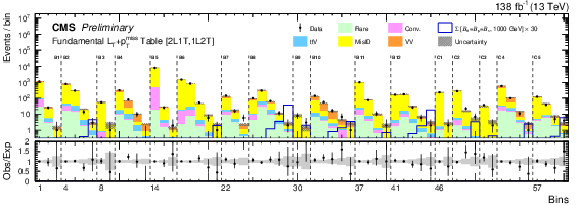
png pdf |
Figure 6-b:
SR distributions of the fundamental $ {L_{\rm T}+ {{p_{\mathrm {T}}} ^\text {miss}}}$ table scheme for the combined Run 2 dataset. The gray bands represent the sum of statistical and systematic uncertainties on the SM background predictions. Expected SM background distributions and uncertainties are shown after fitting the data with the background-only hypothesis. |

png pdf |
Figure 6-c:
SR distributions of the fundamental $ {L_{\rm T}+ {{p_{\mathrm {T}}} ^\text {miss}}}$ table scheme for the combined Run 2 dataset. The gray bands represent the sum of statistical and systematic uncertainties on the SM background predictions. Expected SM background distributions and uncertainties are shown after fitting the data with the background-only hypothesis. |
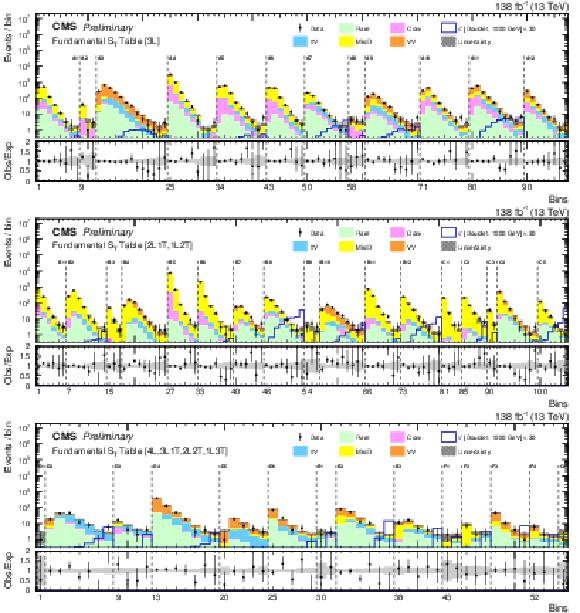
png pdf |
Figure 7:
SR distributions of the fundamental $ {S_{\rm T}}$ table scheme for the combined Run 2 dataset. The gray bands represent the sum of statistical and systematic uncertainties on the SM background predictions. Expected SM background distributions and uncertainties are shown after fitting the data with the background-only hypothesis. |

png pdf |
Figure 7-a:
SR distributions of the fundamental $ {S_{\rm T}}$ table scheme for the combined Run 2 dataset. The gray bands represent the sum of statistical and systematic uncertainties on the SM background predictions. Expected SM background distributions and uncertainties are shown after fitting the data with the background-only hypothesis. |
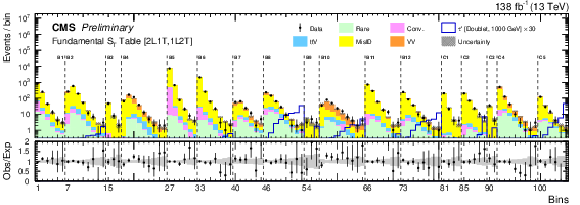
png pdf |
Figure 7-b:
SR distributions of the fundamental $ {S_{\rm T}}$ table scheme for the combined Run 2 dataset. The gray bands represent the sum of statistical and systematic uncertainties on the SM background predictions. Expected SM background distributions and uncertainties are shown after fitting the data with the background-only hypothesis. |

png pdf |
Figure 7-c:
SR distributions of the fundamental $ {S_{\rm T}}$ table scheme for the combined Run 2 dataset. The gray bands represent the sum of statistical and systematic uncertainties on the SM background predictions. Expected SM background distributions and uncertainties are shown after fitting the data with the background-only hypothesis. |

png pdf |
Figure 8:
3L SR distributions of the advanced table scheme for the combined Run 2 dataset. The gray bands represent the sum of statistical and systematic uncertainties on the SM background predictions. Expected SM background distributions and uncertainties are shown after fitting the data with the background-only hypothesis. |
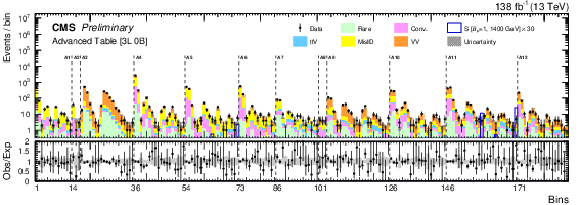
png pdf |
Figure 8-a:
3L SR distributions of the advanced table scheme for the combined Run 2 dataset. The gray bands represent the sum of statistical and systematic uncertainties on the SM background predictions. Expected SM background distributions and uncertainties are shown after fitting the data with the background-only hypothesis. |

png pdf |
Figure 8-b:
3L SR distributions of the advanced table scheme for the combined Run 2 dataset. The gray bands represent the sum of statistical and systematic uncertainties on the SM background predictions. Expected SM background distributions and uncertainties are shown after fitting the data with the background-only hypothesis. |

png pdf |
Figure 8-c:
3L SR distributions of the advanced table scheme for the combined Run 2 dataset. The gray bands represent the sum of statistical and systematic uncertainties on the SM background predictions. Expected SM background distributions and uncertainties are shown after fitting the data with the background-only hypothesis. |

png pdf |
Figure 9:
2L1T SR distributions of the advanced table scheme for the combined Run 2 dataset. The gray bands represent the sum of statistical and systematic uncertainties on the SM background predictions. Expected SM background distributions and uncertainties are shown after fitting the data with the background-only hypothesis. |
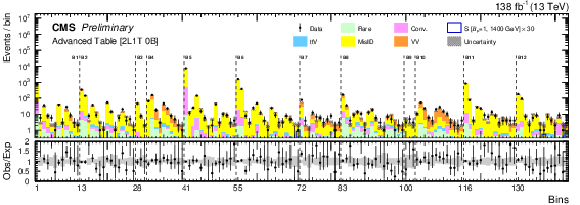
png pdf |
Figure 9-a:
2L1T SR distributions of the advanced table scheme for the combined Run 2 dataset. The gray bands represent the sum of statistical and systematic uncertainties on the SM background predictions. Expected SM background distributions and uncertainties are shown after fitting the data with the background-only hypothesis. |

png pdf |
Figure 9-b:
2L1T SR distributions of the advanced table scheme for the combined Run 2 dataset. The gray bands represent the sum of statistical and systematic uncertainties on the SM background predictions. Expected SM background distributions and uncertainties are shown after fitting the data with the background-only hypothesis. |

png pdf |
Figure 9-c:
2L1T SR distributions of the advanced table scheme for the combined Run 2 dataset. The gray bands represent the sum of statistical and systematic uncertainties on the SM background predictions. Expected SM background distributions and uncertainties are shown after fitting the data with the background-only hypothesis. |
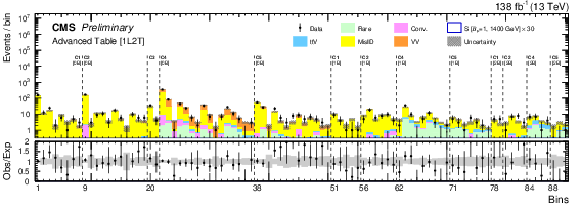
png pdf |
Figure 10:
1L2T SR distribution of the advanced table scheme for the combined Run 2 dataset. The gray bands represent the sum of statistical and systematic uncertainties on the SM background predictions. Expected SM background distributions and uncertainties are shown after fitting the data with the background-only hypothesis. |
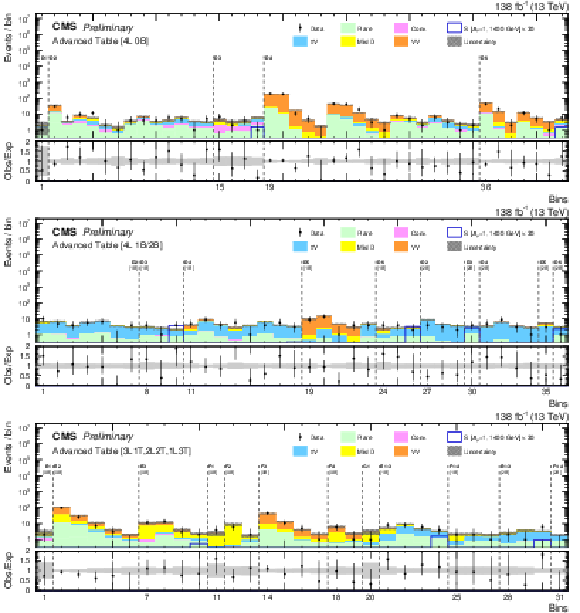
png pdf |
Figure 11:
4L, 3L1T, 2L2T and 1L3T SR distributions of the advanced table scheme for the combined Run 2 dataset. The gray bands represent the sum of statistical and systematic uncertainties on the SM background predictions. Expected SM background distributions and uncertainties are shown after fitting the data with the background-only hypothesis. |
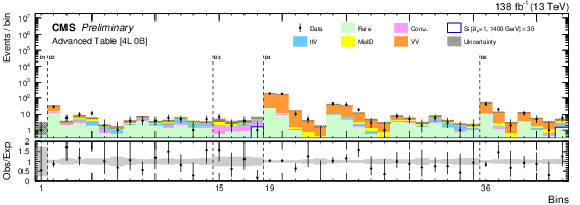
png pdf |
Figure 11-a:
4L, 3L1T, 2L2T and 1L3T SR distributions of the advanced table scheme for the combined Run 2 dataset. The gray bands represent the sum of statistical and systematic uncertainties on the SM background predictions. Expected SM background distributions and uncertainties are shown after fitting the data with the background-only hypothesis. |

png pdf |
Figure 11-b:
4L, 3L1T, 2L2T and 1L3T SR distributions of the advanced table scheme for the combined Run 2 dataset. The gray bands represent the sum of statistical and systematic uncertainties on the SM background predictions. Expected SM background distributions and uncertainties are shown after fitting the data with the background-only hypothesis. |

png pdf |
Figure 11-c:
4L, 3L1T, 2L2T and 1L3T SR distributions of the advanced table scheme for the combined Run 2 dataset. The gray bands represent the sum of statistical and systematic uncertainties on the SM background predictions. Expected SM background distributions and uncertainties are shown after fitting the data with the background-only hypothesis. |

png pdf |
Figure 12:
SS-M $\mathcal {B}_{\mathrm{e}}=\mathcal {B}_{\mu}=\mathcal {B}_{\tau}$ BDT regions for the 3-lepton (top) and 4-lepton (bottom) channels for the combined Run 2 dataset. The gray bands represent the sum of statistical and systematic uncertainties on the SM background predictions. Expected SM background distributions and uncertainties are shown after fitting the data with the background-only hypothesis. |

png pdf |
Figure 12-a:
SS-M $\mathcal {B}_{\mathrm{e}}=\mathcal {B}_{\mu}=\mathcal {B}_{\tau}$ BDT regions for the 3-lepton channel for the combined Run 2 dataset. The gray bands represent the sum of statistical and systematic uncertainties on the SM background predictions. Expected SM background distributions and uncertainties are shown after fitting the data with the background-only hypothesis. |

png pdf |
Figure 12-b:
SS-M $\mathcal {B}_{\mathrm{e}}=\mathcal {B}_{\mu}=\mathcal {B}_{\tau}$ BDT regions for the 4-lepton channel for the combined Run 2 dataset. The gray bands represent the sum of statistical and systematic uncertainties on the SM background predictions. Expected SM background distributions and uncertainties are shown after fitting the data with the background-only hypothesis. |
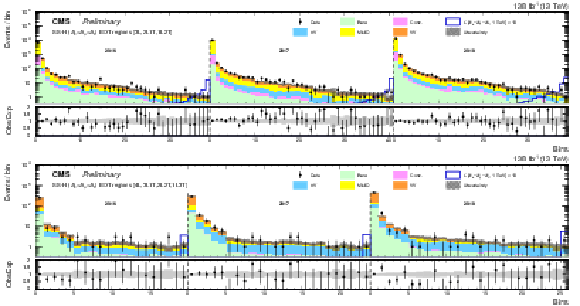
png pdf |
Figure 13:
SS-H $\mathcal {B}_{\mathrm{e}}=\mathcal {B}_{\mu}=\mathcal {B}_{\tau}$ BDT regions for the 3-lepton (top) and 4-lepton (bottom) channels for the combined Run 2 dataset. The gray bands represent the sum of statistical and systematic uncertainties on the SM background predictions. Expected SM background distributions and uncertainties are shown after fitting the data with the background-only hypothesis. |

png pdf |
Figure 13-a:
SS-H $\mathcal {B}_{\mathrm{e}}=\mathcal {B}_{\mu}=\mathcal {B}_{\tau}$ BDT regions for the 3-lepton channel for the combined Run 2 dataset. The gray bands represent the sum of statistical and systematic uncertainties on the SM background predictions. Expected SM background distributions and uncertainties are shown after fitting the data with the background-only hypothesis. |

png pdf |
Figure 13-b:
SS-H $\mathcal {B}_{\mathrm{e}}=\mathcal {B}_{\mu}=\mathcal {B}_{\tau}$ BDT regions for the 4-lepton channel for the combined Run 2 dataset. The gray bands represent the sum of statistical and systematic uncertainties on the SM background predictions. Expected SM background distributions and uncertainties are shown after fitting the data with the background-only hypothesis. |
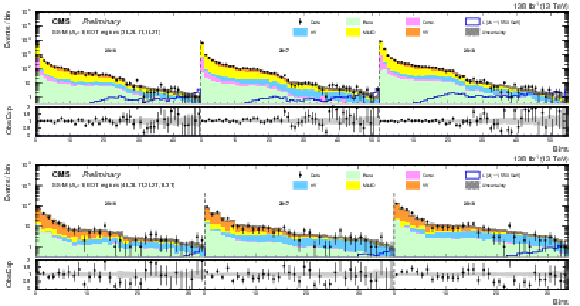
png pdf |
Figure 14:
SS-M $\mathcal {B}_{\tau}=$ 1 BDT regions for the 3-lepton (top) and 4-lepton (bottom) channels for the combined Run 2 dataset. The gray bands represent the sum of statistical and systematic uncertainties on the SM background predictions. Expected SM background distributions and uncertainties are shown after fitting the data with the background-only hypothesis. |

png pdf |
Figure 14-a:
SS-M $\mathcal {B}_{\tau}=$ 1 BDT regions for the 3-lepton channel for the combined Run 2 dataset. The gray bands represent the sum of statistical and systematic uncertainties on the SM background predictions. Expected SM background distributions and uncertainties are shown after fitting the data with the background-only hypothesis. |

png pdf |
Figure 14-b:
SS-M $\mathcal {B}_{\tau}=$ 1 BDT regions for the 4-lepton channel for the combined Run 2 dataset. The gray bands represent the sum of statistical and systematic uncertainties on the SM background predictions. Expected SM background distributions and uncertainties are shown after fitting the data with the background-only hypothesis. |

png pdf |
Figure 15:
SS-H $\mathcal {B}_{\tau}=$ 1 BDT regions for the 3-lepton (top) and 4-lepton (bottom) channels for the combined Run 2 dataset. The gray bands represent the sum of statistical and systematic uncertainties on the SM background predictions. Expected SM background distributions and uncertainties are shown after fitting the data with the background-only hypothesis. |

png pdf |
Figure 15-a:
SS-H $\mathcal {B}_{\tau}=$ 1 BDT regions for the 3-lepton channel for the combined Run 2 dataset. The gray bands represent the sum of statistical and systematic uncertainties on the SM background predictions. Expected SM background distributions and uncertainties are shown after fitting the data with the background-only hypothesis. |

png pdf |
Figure 15-b:
SS-H $\mathcal {B}_{\tau}=$ 1 BDT regions for the 4-lepton channel for the combined Run 2 dataset. The gray bands represent the sum of statistical and systematic uncertainties on the SM background predictions. Expected SM background distributions and uncertainties are shown after fitting the data with the background-only hypothesis. |

png pdf |
Figure 16:
VLL-M BDT regions for the 3-lepton (top) and 4-lepton (bottom) channels for the combined Run 2 dataset. The gray bands represent the sum of statistical and systematic uncertainties on the SM background predictions. Expected SM background distributions and uncertainties are shown after fitting the data with the background-only hypothesis. |

png pdf |
Figure 16-a:
VLL-M BDT regions for the 3-lepton channel for the combined Run 2 dataset. The gray bands represent the sum of statistical and systematic uncertainties on the SM background predictions. Expected SM background distributions and uncertainties are shown after fitting the data with the background-only hypothesis. |

png pdf |
Figure 16-b:
VLL-M BDT regions for the 4-lepton channel for the combined Run 2 dataset. The gray bands represent the sum of statistical and systematic uncertainties on the SM background predictions. Expected SM background distributions and uncertainties are shown after fitting the data with the background-only hypothesis. |
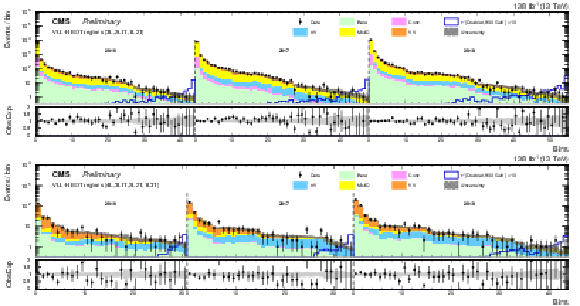
png pdf |
Figure 17:
VLL-H BDT regions for the 3-lepton (top) and 4-lepton (bottom) channels for the combined Run 2 dataset. The gray bands represent the sum of statistical and systematic uncertainties on the SM background predictions. Expected SM background distributions and uncertainties are shown after fitting the data with the background-only hypothesis. |

png pdf |
Figure 17-a:
VLL-H BDT regions for the 3-lepton channel for the combined Run 2 dataset. The gray bands represent the sum of statistical and systematic uncertainties on the SM background predictions. Expected SM background distributions and uncertainties are shown after fitting the data with the background-only hypothesis. |

png pdf |
Figure 17-b:
VLL-H BDT regions for the 4-lepton channel for the combined Run 2 dataset. The gray bands represent the sum of statistical and systematic uncertainties on the SM background predictions. Expected SM background distributions and uncertainties are shown after fitting the data with the background-only hypothesis. |

png pdf |
Figure 18:
LQ-M $\mathcal {B}_{\tau}=$ 1 BDT regions for the 3-lepton (top) and 4-lepton (bottom) channels for the combined Run 2 dataset. The gray bands represent the sum of statistical and systematic uncertainties on the SM background predictions. Expected SM background distributions and uncertainties are shown after fitting the data with the background-only hypothesis. |

png pdf |
Figure 18-a:
LQ-M $\mathcal {B}_{\tau}=$ 1 BDT regions for the 3-lepton channel for the combined Run 2 dataset. The gray bands represent the sum of statistical and systematic uncertainties on the SM background predictions. Expected SM background distributions and uncertainties are shown after fitting the data with the background-only hypothesis. |

png pdf |
Figure 18-b:
LQ-M $\mathcal {B}_{\tau}=$ 1 BDT regions for the 4-lepton channel for the combined Run 2 dataset. The gray bands represent the sum of statistical and systematic uncertainties on the SM background predictions. Expected SM background distributions and uncertainties are shown after fitting the data with the background-only hypothesis. |
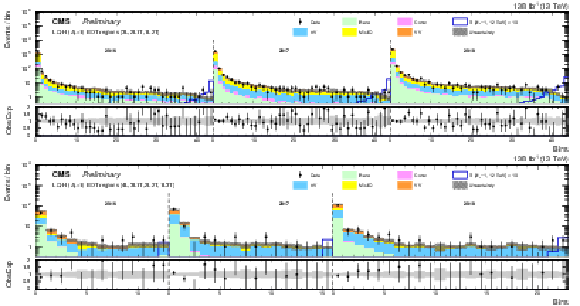
png pdf |
Figure 19:
LQ-H $\mathcal {B}_{\tau}=$ 1 BDT regions for the 3-lepton (top) and 4-lepton (bottom) channels for the combined Run 2 dataset. The gray bands represent the sum of statistical and systematic uncertainties on the SM background predictions. Expected SM background distributions and uncertainties are shown after fitting the data with the background-only hypothesis. |

png pdf |
Figure 19-a:
LQ-H $\mathcal {B}_{\tau}=$ 1 BDT regions for the 4-lepton channel for the combined Run 2 dataset. The gray bands represent the sum of statistical and systematic uncertainties on the SM background predictions. Expected SM background distributions and uncertainties are shown after fitting the data with the background-only hypothesis. |

png pdf |
Figure 19-b:
LQ-H $\mathcal {B}_{\tau}=$ 1 BDT regions for the 3-lepton (top) and 4-lepton (bottom) channels for the combined Run 2 dataset. The gray bands represent the sum of statistical and systematic uncertainties on the SM background predictions. Expected SM background distributions and uncertainties are shown after fitting the data with the background-only hypothesis. |
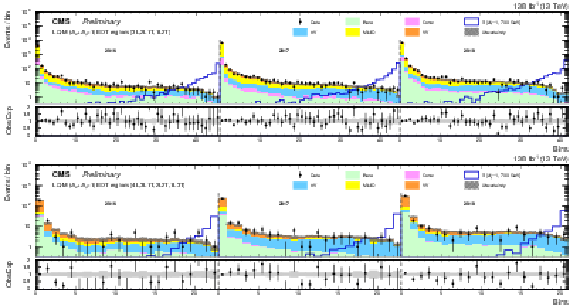
png pdf |
Figure 20:
LQ-M $\mathcal {B}_{\mathrm{e}}+\mathcal {B}_{\mu}=$ 1 BDT regions for the 3-lepton (top) and 4-lepton (bottom) channels for the combined Run 2 dataset. The gray bands represent the sum of statistical and systematic uncertainties on the SM background predictions. Expected SM background distributions and uncertainties are shown after fitting the data with the background-only hypothesis. |

png pdf |
Figure 20-a:
LQ-M $\mathcal {B}_{\mathrm{e}}+\mathcal {B}_{\mu}=$ 1 BDT regions for the 3-lepton channel for the combined Run 2 dataset. The gray bands represent the sum of statistical and systematic uncertainties on the SM background predictions. Expected SM background distributions and uncertainties are shown after fitting the data with the background-only hypothesis. |

png pdf |
Figure 20-b:
LQ-M $\mathcal {B}_{\mathrm{e}}+\mathcal {B}_{\mu}=$ 1 BDT regions for the 4-lepton channel for the combined Run 2 dataset. The gray bands represent the sum of statistical and systematic uncertainties on the SM background predictions. Expected SM background distributions and uncertainties are shown after fitting the data with the background-only hypothesis. |

png pdf |
Figure 21:
LQ-H $\mathcal {B}_{\mathrm{e}}+\mathcal {B}_{\mu}=$ 1 BDT regions for the 3-lepton (top) and 4-lepton (bottom) channels for the combined Run 2 dataset. The gray bands represent the sum of statistical and systematic uncertainties on the SM background predictions. Expected SM background distributions and uncertainties are shown after fitting the data with the background-only hypothesis. |

png pdf |
Figure 21-a:
LQ-H $\mathcal {B}_{\mathrm{e}}+\mathcal {B}_{\mu}=$ 1 BDT regions for the 3-lepton channel for the combined Run 2 dataset. The gray bands represent the sum of statistical and systematic uncertainties on the SM background predictions. Expected SM background distributions and uncertainties are shown after fitting the data with the background-only hypothesis. |

png pdf |
Figure 21-b:
LQ-H $\mathcal {B}_{\mathrm{e}}+\mathcal {B}_{\mu}=$ 1 BDT regions for the 4-lepton channel for the combined Run 2 dataset. The gray bands represent the sum of statistical and systematic uncertainties on the SM background predictions. Expected SM background distributions and uncertainties are shown after fitting the data with the background-only hypothesis. |
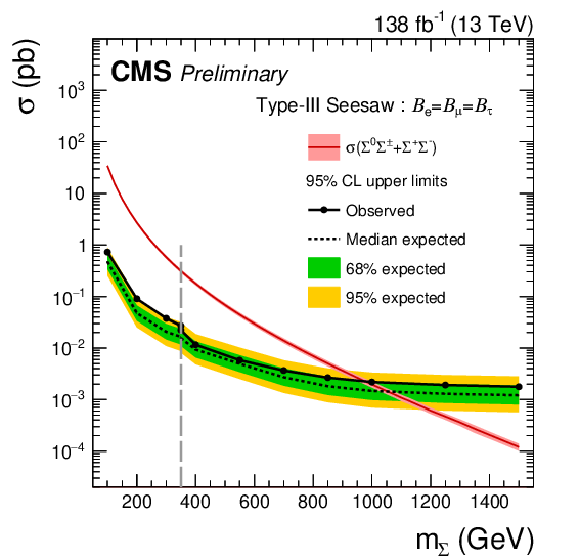
png pdf |
Figure 22:
Observed and expected upper limits at 95% CL on the production cross section for the type-III seesaw fermions in the flavor-democratic scenario using the table schemes and the BDT regions of SS-M and SS-H $\mathcal {B}_{\mathrm{e}}=\mathcal {B}_{\mu}=\mathcal {B}_{\tau}$ BDT. To the left of the vertical dashed gray line, the limits are shown from the advanced $ {S_{\rm T}}$ table, and to the right the limits are shown from the BDT regions. |

png pdf |
Figure 23:
Observed (left) and expected (right) lower limits at 95% CL on the mass for the type-III seesaw fermions in the plane defined by $\mathcal {B}_{\mathrm{e}}$ and $\mathcal {B}_{\tau}$, with the constraint that $\mathcal {B}_{\mathrm{e}} + \mathcal {B}_{\mu} + \mathcal {B}_{\tau}=$ 1. These limits arise from the SS-H $\mathcal {B}_{\tau}=$ 1 BDT when $\mathcal {B}_{\tau} \ge $ 0.9, and by the SS-H $\mathcal {B}_{\mathrm{e}}=\mathcal {B}_{\mu}=\mathcal {B}_{\tau}$ BDT for the other decay branching fraction combinations. |
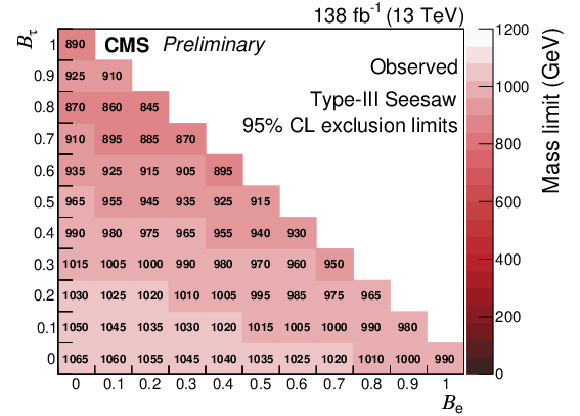
png pdf |
Figure 23-a:
Observed lower limits at 95% CL on the mass for the type-III seesaw fermions in the plane defined by $\mathcal {B}_{\mathrm{e}}$ and $\mathcal {B}_{\tau}$, with the constraint that $\mathcal {B}_{\mathrm{e}} + \mathcal {B}_{\mu} + \mathcal {B}_{\tau}=$ 1. These limits arise from the SS-H $\mathcal {B}_{\tau}=$ 1 BDT when $\mathcal {B}_{\tau} \ge $ 0.9, and by the SS-H $\mathcal {B}_{\mathrm{e}}=\mathcal {B}_{\mu}=\mathcal {B}_{\tau}$ BDT for the other decay branching fraction combinations. |

png pdf |
Figure 23-b:
Expected lower limits at 95% CL on the mass for the type-III seesaw fermions in the plane defined by $\mathcal {B}_{\mathrm{e}}$ and $\mathcal {B}_{\tau}$, with the constraint that $\mathcal {B}_{\mathrm{e}} + \mathcal {B}_{\mu} + \mathcal {B}_{\tau}=$ 1. These limits arise from the SS-H $\mathcal {B}_{\tau}=$ 1 BDT when $\mathcal {B}_{\tau} \ge $ 0.9, and by the SS-H $\mathcal {B}_{\mathrm{e}}=\mathcal {B}_{\mu}=\mathcal {B}_{\tau}$ BDT for the other decay branching fraction combinations. |
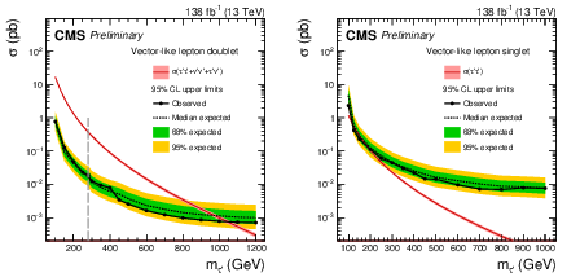
png pdf |
Figure 24:
Observed and expected upper limits at 95% CL on the production cross section for the vector-like tau leptons: doublet model (left), and singlet model (right). For the doublet vector-like lepton model, to the left of the vertical dashed gray line, the limits are shown from the advanced $ {S_{\rm T}}$ table, while to the right the limits are shown from the BDT regions. For the singlet vector-like lepton model, the limit is shown from the advanced $ {S_{\rm T}}$ table for all masses. |
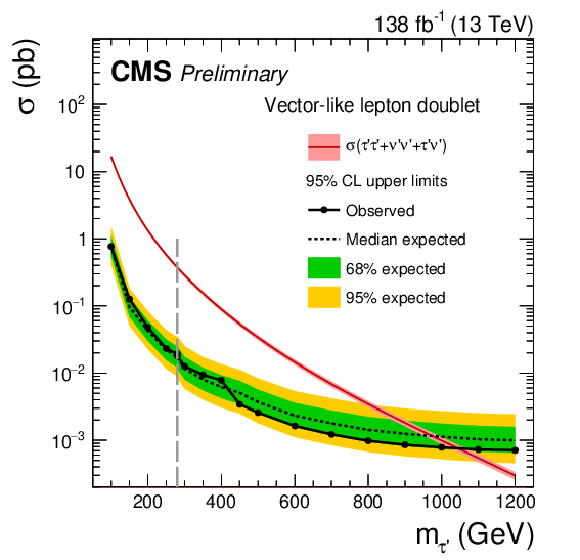
png pdf |
Figure 24-a:
Observed and expected upper limits at 95% CL on the production cross section for the doublet vector-like tau lepton model. To the left of the vertical dashed gray line, the limits are shown from the advanced $ {S_{\rm T}}$ table, while to the right the limits are shown from the BDT regions. |
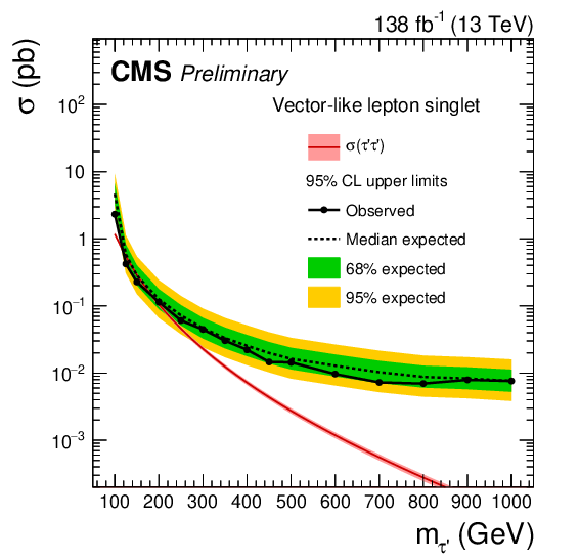
png pdf |
Figure 24-b:
Observed and expected upper limits at 95% CL on the production cross section for the singlet vector-like tau lepton model. The limit is shown from the advanced $ {S_{\rm T}}$ table for all masses. |

png pdf |
Figure 25:
Observed and expected upper limits at 95% CL on the production cross section for the scalar leptoquarks: $\mathcal {B}_{\mathrm{e}}=$ 1 coupling (upper left), $\mathcal {B}_{\mu}=$ 1 coupling (upper right), and $\mathcal {B}_{\tau}=$ 1 coupling (lower). In each figure, the limits to the left of the vertical dashed gray line are shown from the advanced $ {S_{\rm T}}$ table, and to the right are shown from the BDT regions. |
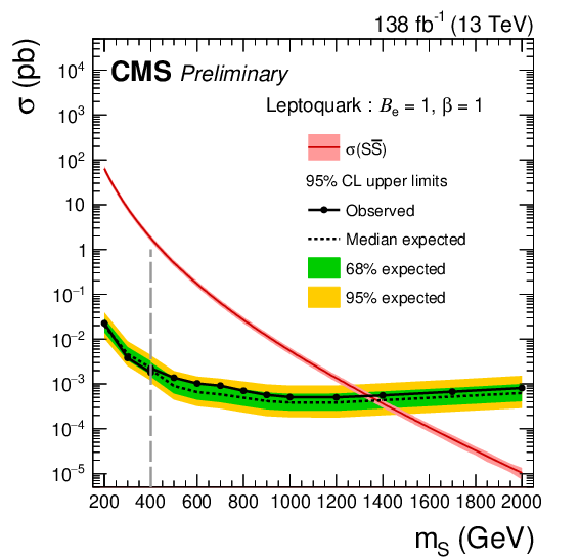
png pdf |
Figure 25-a:
Observed and expected upper limits at 95% CL on the production cross section for the scalar leptoquarks with $\mathcal {B}_{\mathrm{e}}=$ 1 coupling. The limits to the left of the vertical dashed gray line are shown from the advanced $ {S_{\rm T}}$ table, and to the right are shown from the BDT regions. |

png pdf |
Figure 25-b:
Observed and expected upper limits at 95% CL on the production cross section for the scalar leptoquarks with $\mathcal {B}_{\mu}=$ 1 coupling. The limits to the left of the vertical dashed gray line are shown from the advanced $ {S_{\rm T}}$ table, and to the right are shown from the BDT regions. |
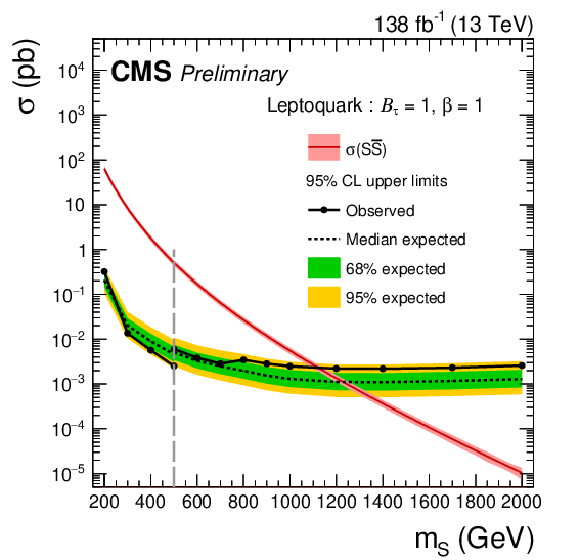
png pdf |
Figure 25-c:
Observed and expected upper limits at 95% CL on the production cross section for the scalar leptoquarks with $\mathcal {B}_{\tau}=$ 1 coupling. The limits to the left of the vertical dashed gray line are shown from the advanced $ {S_{\rm T}}$ table, and to the right are shown from the BDT regions. |
| Tables | |

png pdf |
Table 1:
Fundamental scheme of event categorization as a function of lepton charge and mass variables. The mass categorizations refer to masses of OSSF pairs if present, and of OSOF pairs otherwise. For categorization purposes, all possible dielectron and dimuon pair masses in the event are considered, whereas only the largest mass in the event in considered for all other pairs. Only the dielectron and dimuon pairs are considered to tag events as OnZ. Disallowed categories are marked with "$-$'', and categories marked with "*'' are inclusive of the unmarked ones in a given OSSF$n$ channel. The 1L3T OSSF0 and OSSF1 events are combined into a single category. Categories A3, A4, A9, A10, B4, and B10 have partially overlapping control region selections that are removed accordingly. |

png pdf |
Table 2:
The binning of $ {L_{\rm T}+ {{p_{\mathrm {T}}} ^\text {miss}}}$ or $ {S_{\rm T}}$ variable for fundamental and advanced table schemes in 3L channel based on categorization described in Table 1. The ranges, as well the $ {p_{\rm T}^{\rm miss}}$ and $ {H_{\mathrm {T}}} $ requirements, are given in GeV. The first bins in the $ {L_{\rm T}+ {{p_{\mathrm {T}}} ^\text {miss}}}$ or $ {S_{\rm T}}$ range contain the underflow, the last bins contain the overflow. |
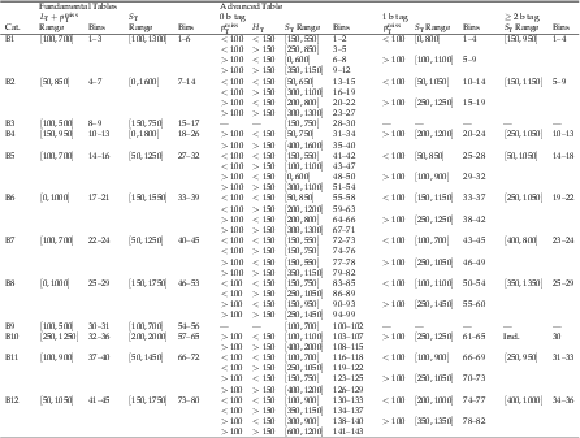
png pdf |
Table 3:
The binning of $ {L_{\rm T}+ {{p_{\mathrm {T}}} ^\text {miss}}}$ or $ {S_{\rm T}}$ variable for fundamental and advanced table schemes in 2L1T channel based on categorization described in Table 1. The ranges, as well as the $ {p_{\rm T}^{\rm miss}}$ and $ {H_{\mathrm {T}}} $ requirements, are given in GeV. The first bins in the $ {L_{\rm T}+ {{p_{\mathrm {T}}} ^\text {miss}}}$ or $ {S_{\rm T}}$ range contain the underflow, and the last bins contain the overflow. |
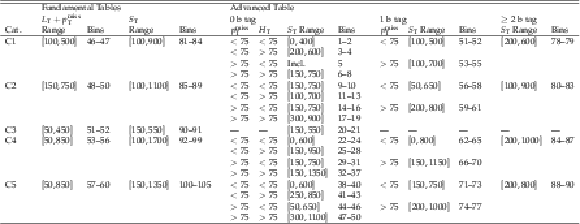
png pdf |
Table 4:
The binning of $ {L_{\rm T}+ {{p_{\mathrm {T}}} ^\text {miss}}}$ or $ {S_{\rm T}}$ variable for fundamental and advanced table schemes in 1L2T channel based on categorization described in Table 1. The ranges, as well as the $ {p_{\rm T}^{\rm miss}}$ and $ {H_{\mathrm {T}}} $ requirements, are given in GeV. The first bins in the $ {L_{\rm T}+ {{p_{\mathrm {T}}} ^\text {miss}}}$ or $ {S_{\rm T}}$ range contain the underflow, and the last bins contain the overflow. |

png pdf |
Table 5:
The binning of $ {L_{\rm T}+ {{p_{\mathrm {T}}} ^\text {miss}}}$ or $ {S_{\rm T}}$ variable for fundamental and advanced table schemes in 4L, 3L1T, 2L2T and 1L3T channels based on categorization described in Table 1. The ranges, as well as the $ {p_{\rm T}^{\rm miss}}$ and $ {H_{\mathrm {T}}} $ requirements, are given in GeV. The first bins in the $ {L_{\rm T}+ {{p_{\mathrm {T}}} ^\text {miss}}}$ or $ {S_{\rm T}}$ range contain the underflow, and the last bins contain the overflow. For the 3L1T and 2L2T channels, multiple categories are combined in the 1 or $\geq $2 b tag selections. These bins are marked with dagger characters. |

png pdf |
Table 6:
Input variables used for the BDTs trained for the various BSM models. Note that the indices $i,j$ run over the leptons of all flavors ($i,j=1,2,3,4$) in a given event. If a given variable is not defined in a given channel, the variable is set to a non-physical default value for signal and background processes, and plays no role in training. |

png pdf |
Table 7:
Signal mass points as used in the trainings of BDTs and as used in the evaluation in the SRs according to the best sensitivity. The L, M, and H denote low, medium, and high mass ranges respectively. |
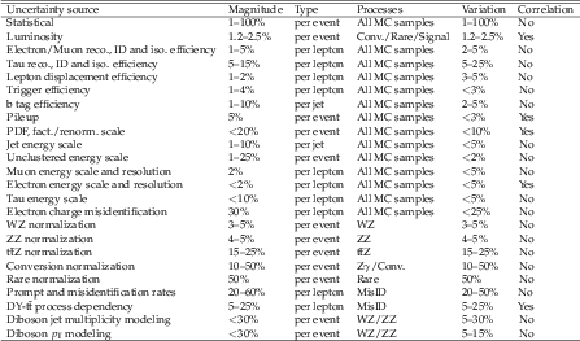
png pdf |
Table 8:
Sources, magnitudes, effective variations, and correlation model of systematic uncertainties in SRs. Uncertainty sources marked as "Yes'' under the correlation model have their nuisance parameters correlated across the 3 years of data collection. |
| Summary |
|
A search has been performed for physics beyond the standard model, using multilepton events in 138 fb$^{-1}$ of pp collision data at $\sqrt{s} = $ 13 TeV, collected with the CMS detector using the LHC Run 2 dataset. The search is carried out in seven orthogonal channels based on the number of light leptons and hadronically decaying tau leptons. Three cut-based schemes are used to define SRs for the search. In addition, for each model scenario considered, a BDT is used to define model-specific SRs. In all cases, the observations are found to be consistent with the expectations from the standard model processes. Constraints are set on the production cross section of a number of BSM signal models predicting a variety of multilepton final states. Type-III seesaw heavy fermions are excluded at 95% CL with masses below 980 GeV (expected 1060 GeV), assuming flavor-democratic mixings to SM leptons, and below 995 GeV (expected 1065 GeV), 1070 GeV (expected 1145 GeV), and 890 GeV (expected 885 GeV), assuming mixings exclusively with electron, muon, and tau flavors, respectively. Lower limits on the masses of the heavy fermions are also presented for various decay branching fractions of the heavy fermions to the different standard model lepton flavors. These are the strongest constraints on the type-III seesaw heavy fermions to date. In the vector-like lepton doublet model, vector-like tau leptons are excluded at 95% CL with masses below 1045 GeV (expected 975 GeV). These are the most stringent constraints on the doublet model. In the singlet model the expected exclusion mass range is 125-150 GeV, while the observed exclusion mass range is 125-170 GeV. These are the first LHC constraints on the singlet model. Scalar leptoquarks coupling to top quarks and individual lepton flavors are also probed. In the scenario with the leptoquark coupling to a top quark and a tau lepton, leptoquarks with masses below 1120 GeV are excluded at 95% CL (expected 1235 GeV). Leptoquarks are excluded with masses below 1340 GeV (expected 1370 GeV) in the top-electron coupling scenario, and below 1420 GeV (expected 1460 GeV) in the top-muon scenario. |
| Additional Figures | |
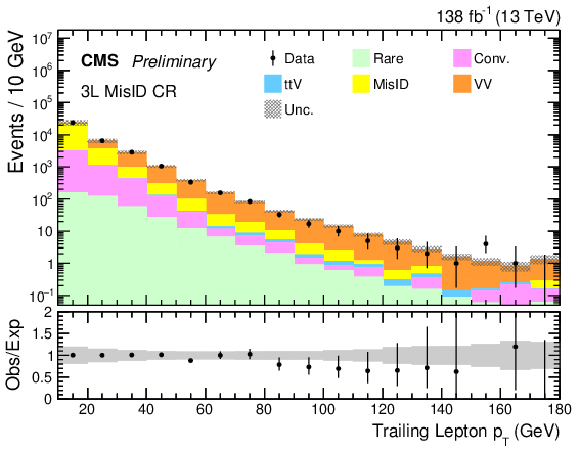
png pdf |
Additional Figure 1:
The $ {p_{\mathrm {T}}} $ distribution of the trailing lepton in 3L MisID CR events. The rightmost bin contains the overflow events. The gray bands represent the sum of statistical and systematic uncertainties on the SM background prediction. |

png pdf |
Additional Figure 2:
The $S_{\rm T}$ distribution in 3L WZ CR events. The rightmost bin contains the overflow events. The gray bands represent the sum of statistical and systematic uncertainties on the SM background prediction. |
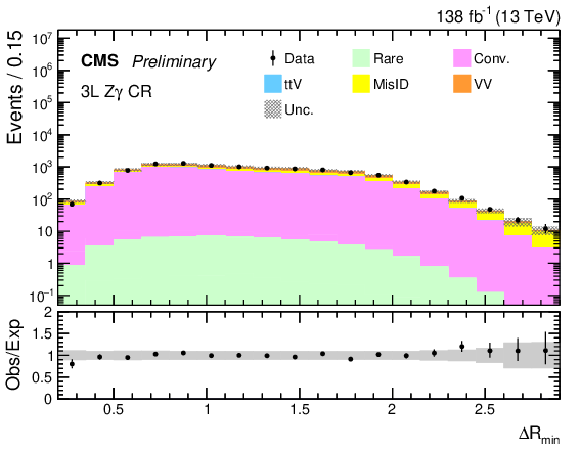
png pdf |
Additional Figure 3:
The $\Delta {R}_{\rm min}$ distribution in 3L Z$\gamma$ CR events. The rightmost bin contains the overflow events. The gray bands represent the sum of statistical and systematic uncertainties on the SM background prediction. |

png pdf |
Additional Figure 4:
The model independent fundamental table categories, as defined in Table 1. The gray bands represent the sum of statistical and systematic uncertainties on the SM background prediction. |

png pdf |
Additional Figure 5:
The $N_{\rm b}$ distribution in 3L, 2L1T, and 1L2T events. The rightmost bin contains the overflow events. The gray bands represent the sum of statistical and systematic uncertainties on the SM background prediction. |
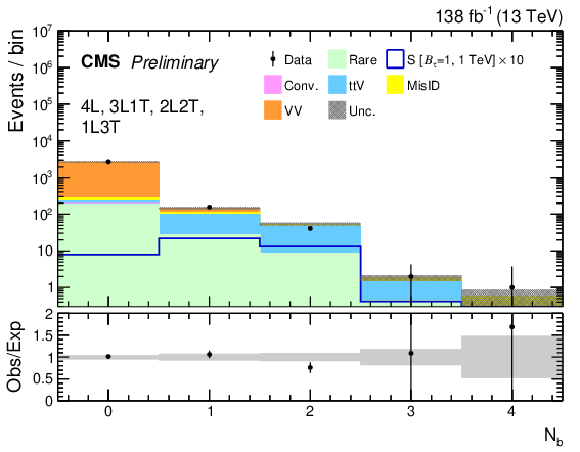
png pdf |
Additional Figure 6:
The $N_{\rm b}$ distribution in 4L, 3L1T, 2L2T, and 1L3T events. The rightmost bin contains the overflow events. The gray bands represent the sum of statistical and systematic uncertainties on the SM background prediction. |

png pdf |
Additional Figure 7:
The $N_{\rm b}$ distribution in 4L, 3L1T, 3L, 2L2T, 2L1T, 1L3T, and 1L2T events. The rightmost bin contains the overflow events. The gray bands represent the sum of statistical and systematic uncertainties on the SM background prediction. |
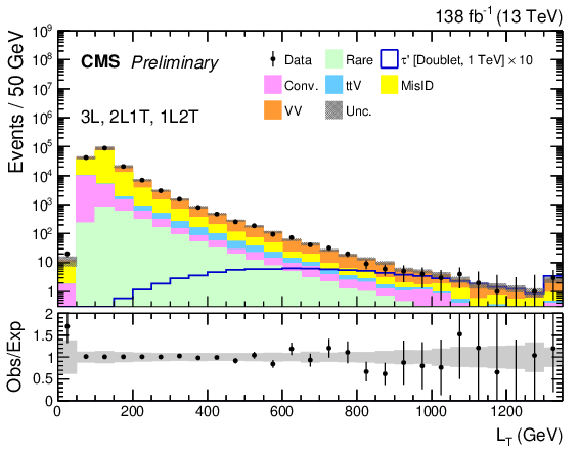
png pdf |
Additional Figure 8:
The $L_{\rm T}$ distribution in 3L, 2L1T, and 1L2T events. The rightmost bin contains the overflow events. The gray bands represent the sum of statistical and systematic uncertainties on the SM background prediction. |

png pdf |
Additional Figure 9:
The $L_{\rm T}$ distribution in 4L, 3L1T, 3L, 2L2T, 2L1T, 1L3T, and 1L2T events. The rightmost bin contains the overflow events. The gray bands represent the sum of statistical and systematic uncertainties on the SM background prediction. |
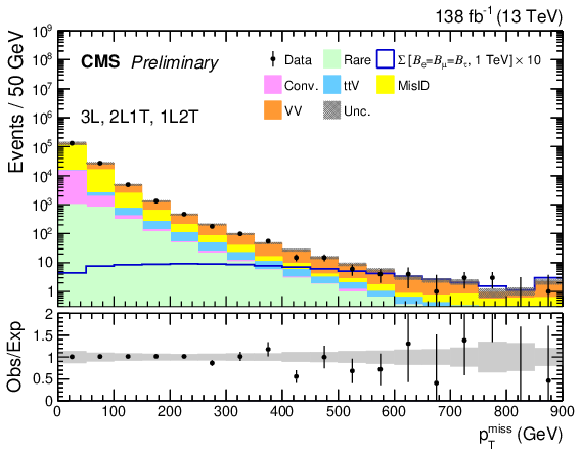
png pdf |
Additional Figure 10:
The $ {{p_{\mathrm {T}}} ^\text {miss}} $ distribution in 3L, 2L1T, and 1L2T events. The rightmost bin contains the overflow events. The gray bands represent the sum of statistical and systematic uncertainties on the SM background prediction. |

png pdf |
Additional Figure 11:
The $ {{p_{\mathrm {T}}} ^\text {miss}} $ distribution in 4L, 3L1T, 3L, 2L2T, 2L1T, 1L3T, and 1L2T events. The rightmost bin contains the overflow events. The gray bands represent the sum of statistical and systematic uncertainties on the SM background prediction. |

png pdf |
Additional Figure 12:
The $H_{\rm T}$ distribution in 3L, 2L1T, and 1L2T events. The rightmost bin contains the overflow events. The gray bands represent the sum of statistical and systematic uncertainties on the SM background prediction. |

png pdf |
Additional Figure 13:
The $H_{\rm T}$ distribution in 4L, 3L1T, 3L, 2L2T, 2L1T, 1L3T, and 1L2T events. The rightmost bin contains the overflow events. The gray bands represent the sum of statistical and systematic uncertainties on the SM background prediction. |
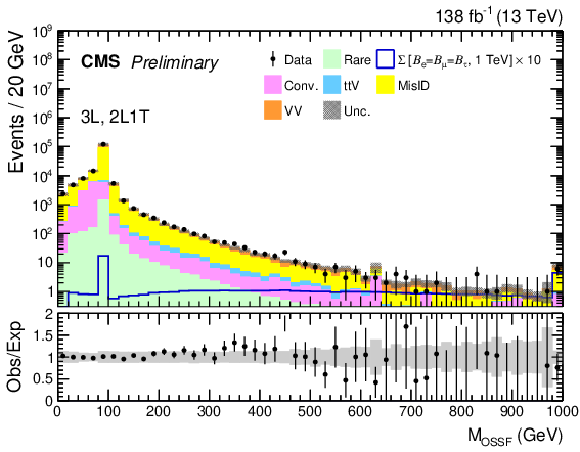
png pdf |
Additional Figure 14:
The $M_{\rm OSSF}$ distribution in 3L and 2L1T events. The rightmost bin contains the overflow events. The gray bands represent the sum of statistical and systematic uncertainties on the SM background prediction. |
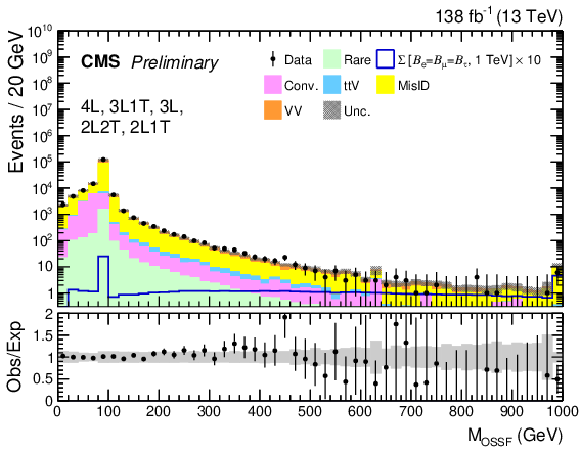
png pdf |
Additional Figure 15:
The $M_{\rm OSSF}$ distribution in 4L, 3L1T, 3L, 2L2T, and 2L1T events. The rightmost bin contains the overflow events. The gray bands represent the sum of statistical and systematic uncertainties on the SM background prediction. |

png pdf |
Additional Figure 16:
The invariant mass distribution of the opposite-sign other-flavor ($M_{\rm OSOF}$) light lepton pair in 3L and 2L1T events. The rightmost bin contains the overflow events. The gray bands represent the sum of statistical and systematic uncertainties on the SM background prediction. |
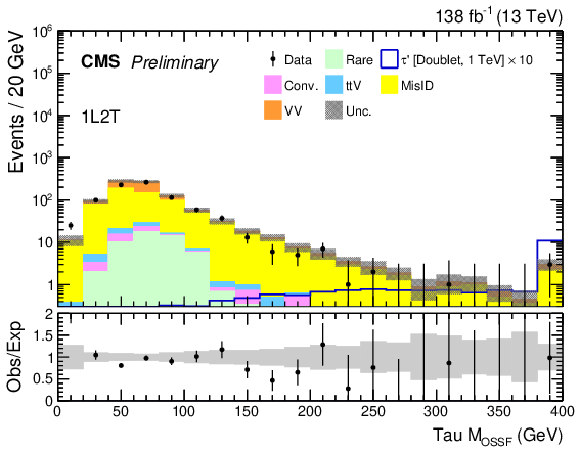
png pdf |
Additional Figure 17:
The invariant mass distribution of the opposite-sign same-flavor ($M_{\rm OSSF}$) tau lepton pair in 1L2T events. The rightmost bin contains the overflow events. The gray bands represent the sum of statistical and systematic uncertainties on the SM background prediction. |

png pdf |
Additional Figure 18:
The invariant mass distribution of the opposite-sign same-flavor ($M_{\rm OSSF}$) tau lepton pair in 2L2T, 1L3T, and 1L2T events. The rightmost bin contains the overflow events. The gray bands represent the sum of statistical and systematic uncertainties on the SM background prediction. |
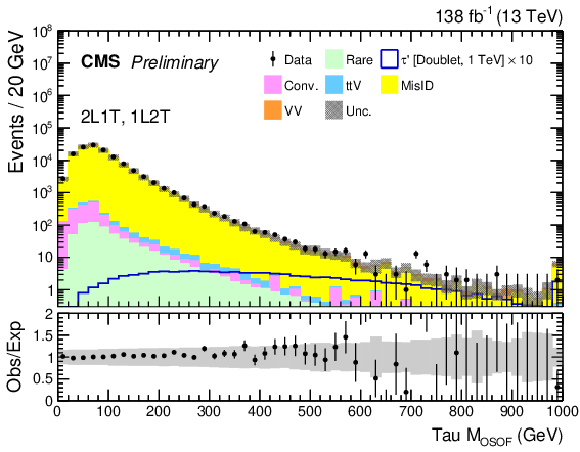
png pdf |
Additional Figure 19:
The invariant mass distribution of the opposite-sign other-flavor ($M_{\rm OSOF}$) light lepton and tau lepton pair in 2L1T and 1L2T events. The rightmost bin contains the overflow events. The gray bands represent the sum of statistical and systematic uncertainties on the SM background prediction. |

png pdf |
Additional Figure 20:
The $M_{\rm T}^{\textrm {1}}$ in 3L, 2L1T, and 1L2T events. The rightmost bin contains the overflow events. The gray bands represent the sum of statistical and systematic uncertainties on the SM background prediction. |
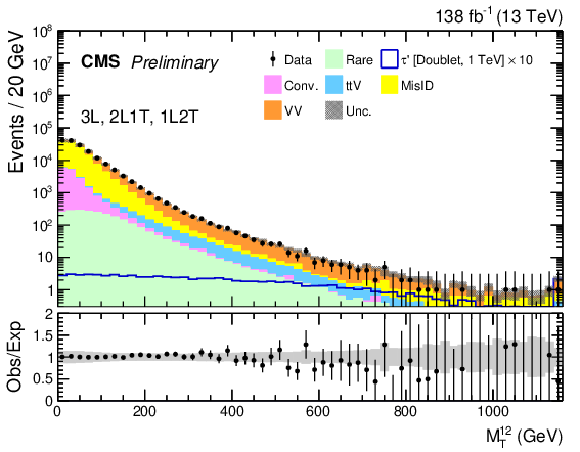
png pdf |
Additional Figure 21:
The $M_{\rm T}^{\textrm {12}}$ in 3L, 2L1T, and 1L2T events. The rightmost bin contains the overflow events. The gray bands represent the sum of statistical and systematic uncertainties on the SM background prediction. |
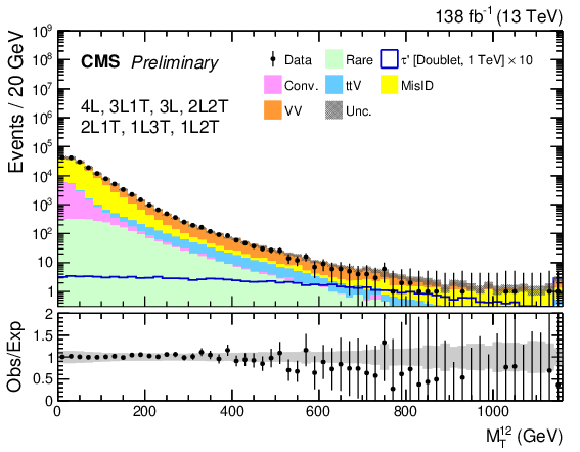
png pdf |
Additional Figure 22:
The $M_{\rm T}^{\textrm {12}}$ in 4L, 3L1T, 2L2T, 2L1T, 1L3T, and 1L2T events. The rightmost bin contains the overflow events. The gray bands represent the sum of statistical and systematic uncertainties on the SM background prediction. |
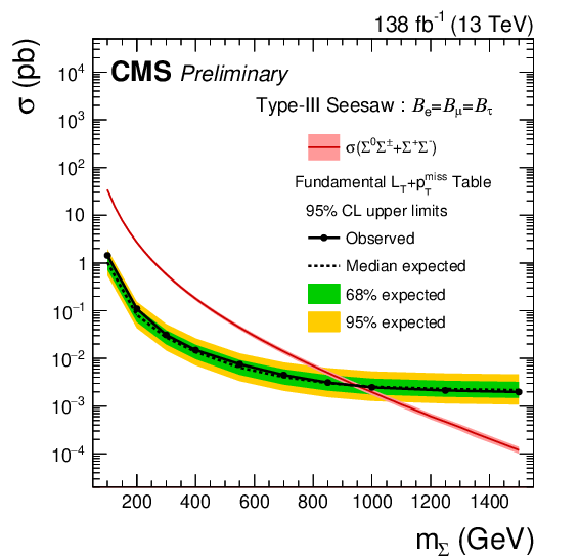
png pdf |
Additional Figure 23:
Observed and expected upper limits at 95% CL on the production cross section for the type-III seesaw fermions in the flavor-democratic scenario using the fundamental $L_{\rm T}+ {{p_{\mathrm {T}}} ^\text {miss}} $ table scheme. |

png pdf |
Additional Figure 24:
Observed and expected upper limits at 95% CL on the production cross section for the type-III seesaw fermions in the flavor-democratic scenario using the fundamental $S_{\rm T}$ table scheme. |

png pdf |
Additional Figure 25:
Observed and expected upper limits at 95% CL on the production cross section for the type-III seesaw fermions in the flavor-democratic scenario using the advanced $S_{\rm T}$ table scheme. |
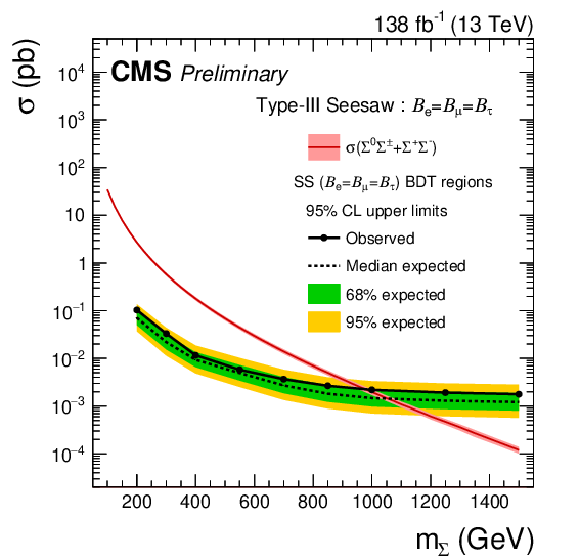
png pdf |
Additional Figure 26:
Observed and expected upper limits at 95% CL on the production cross section for the type-III seesaw fermions in the flavor-democratic scenario using the SS ($\mathcal {B}_{{\mathrm {e}}}=\mathcal {B}_{{\mu}}=\mathcal {B}_{{\tau}}$) BDT regions. |

png pdf |
Additional Figure 27:
Observed and expected upper limits at 95% CL on the production cross section for the type-III seesaw fermions in the $\mathcal {B}_{{\mathrm {e}}}=$ 1 scenario using the fundamental $L_{\rm T}+ {{p_{\mathrm {T}}} ^\text {miss}} $ table scheme. |

png pdf |
Additional Figure 28:
Observed and expected upper limits at 95% CL on the production cross section for the type-III seesaw fermions in the $\mathcal {B}_{{\mathrm {e}}}=$ 1 scenario using the fundamental $S_{\rm T}$ table scheme. |

png pdf |
Additional Figure 29:
Observed and expected upper limits at 95% CL on the production cross section for the type-III seesaw fermions in the $\mathcal {B}_{{\mathrm {e}}}=$ 1 scenario using the advanced $S_{\rm T}$ table scheme. |

png pdf |
Additional Figure 30:
Observed and expected upper limits at 95% CL on the production cross section for the type-III seesaw fermions in the $\mathcal {B}_{{\mathrm {e}}}=$ 1 scenario using the SS ($\mathcal {B}_{{\mathrm {e}}}=\mathcal {B}_{{\mu}}=\mathcal {B}_{{\tau}}$) BDT regions. |

png pdf |
Additional Figure 31:
Observed and expected upper limits at 95% CL on the production cross section for the type-III seesaw fermions in the $\mathcal {B}_{{\mu}}=$ 1 scenario using the fundamental $L_{\rm T}+ {{p_{\mathrm {T}}} ^\text {miss}} $ table scheme. |
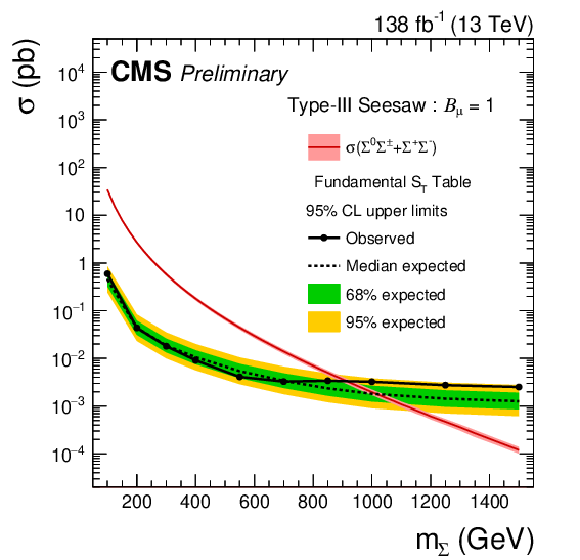
png pdf |
Additional Figure 32:
Observed and expected upper limits at 95% CL on the production cross section for the type-III seesaw fermions in the $\mathcal {B}_{{\mu}}=$ 1 scenario using the fundamental $S_{\rm T}$ table scheme. |

png pdf |
Additional Figure 33:
Observed and expected upper limits at 95% CL on the production cross section for the type-III seesaw fermions in the $\mathcal {B}_{{\mu}}=$ 1 scenario using the advanced $S_{\rm T}$ table scheme. |

png pdf |
Additional Figure 34:
Observed and expected upper limits at 95% CL on the production cross section for the type-III seesaw fermions in the $\mathcal {B}_{{\mu}}=$ 1 scenario using the SS ($\mathcal {B}_{{\mathrm {e}}}=\mathcal {B}_{{\mu}}=\mathcal {B}_{{\tau}}$) BDT regions. |

png pdf |
Additional Figure 35:
Observed and expected upper limits at 95% CL on the production cross section for the type-III seesaw fermions in the $\mathcal {B}_{{\tau}}=$ 1 scenario using the fundamental $L_{\rm T}+ {{p_{\mathrm {T}}} ^\text {miss}} $ table scheme. |

png pdf |
Additional Figure 36:
Observed and expected upper limits at 95% CL on the production cross section for the type-III seesaw fermions in the $\mathcal {B}_{{\tau}}=$ 1 scenario using the fundamental $S_{\rm T}$ table scheme. |
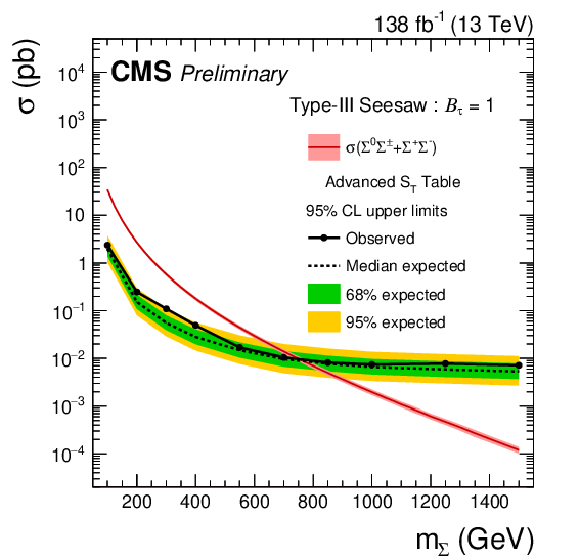
png pdf |
Additional Figure 37:
Observed and expected upper limits at 95% CL on the production cross section for the type-III seesaw fermions in the $\mathcal {B}_{{\tau}}=$ 1 scenario using the advanced $S_{\rm T}$ table scheme. |
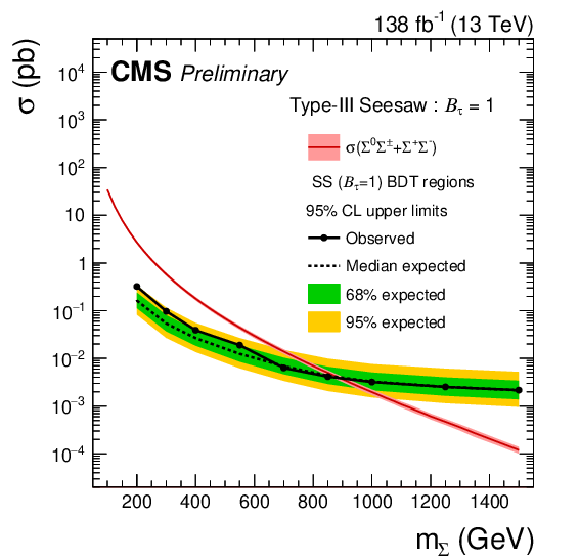
png pdf |
Additional Figure 38:
Observed and expected upper limits at 95% CL on the production cross section for the type-III seesaw fermions in the $\mathcal {B}_{{\tau}}=$ 1 scenario using the SS ($\mathcal {B}_{{\tau}}=$ 1) BDT regions. |

png pdf |
Additional Figure 39:
Observed and expected upper limits at 95% CL on the production cross section for the vector-like tau leptons in the doublet model using the fundamental $L_{\rm T}+ {{p_{\mathrm {T}}} ^\text {miss}} $ table scheme. |
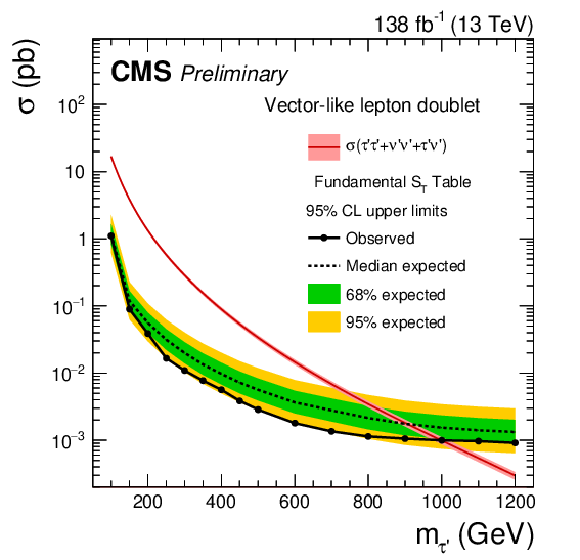
png pdf |
Additional Figure 40:
Observed and expected upper limits at 95% CL on the production cross section for the vector-like tau leptons in the doublet model using the fundamental $S_{\rm T}$ table scheme. |
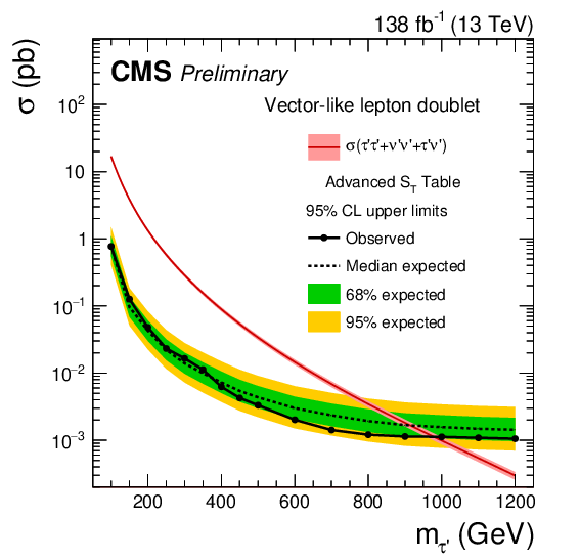
png pdf |
Additional Figure 41:
Observed and expected upper limits at 95% CL on the production cross section for the vector-like tau leptons in the doublet model using the advanced $S_{\rm T}$ table scheme. |

png pdf |
Additional Figure 42:
Observed and expected upper limits at 95% CL on the production cross section for the vector-like tau leptons in the doublet model using the VLL BDT regions. |

png pdf |
Additional Figure 43:
Observed and expected upper limits at 95% CL on the production cross section for the vector-like tau leptons in the singlet model using the fundamental $L_{\rm T}+ {{p_{\mathrm {T}}} ^\text {miss}} $ table scheme. |

png pdf |
Additional Figure 44:
Observed and expected upper limits at 95% CL on the production cross section for the vector-like tau leptons in the singlet model using the fundamental $S_{\rm T}$ table scheme. |
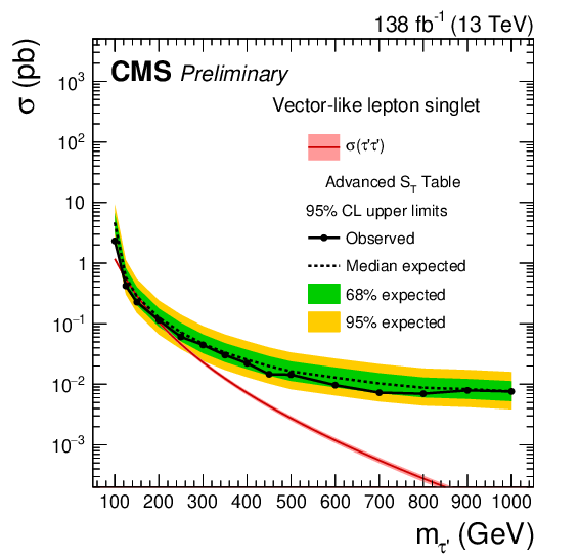
png pdf |
Additional Figure 45:
Observed and expected upper limits at 95% CL on the production cross section for the vector-like tau leptons in the singlet model using the advanced $S_{\rm T}$ table scheme. |

png pdf |
Additional Figure 46:
Observed and expected upper limits at 95% CL on the production cross section for the scalar leptoquarks with $\mathcal {B}_{{\mathrm {e}}}=$ 1 coupling using the fundamental $L_{\rm T}+ {{p_{\mathrm {T}}} ^\text {miss}} $ table scheme. |

png pdf |
Additional Figure 47:
Observed and expected upper limits at 95% CL on the production cross section for the scalar leptoquarks with $\mathcal {B}_{{\mathrm {e}}}=$ 1 coupling using the fundamental $S_{\rm T}$ table scheme. |

png pdf |
Additional Figure 48:
Observed and expected upper limits at 95% CL on the production cross section for the scalar leptoquarks with $\mathcal {B}_{{\mathrm {e}}}=$ 1 coupling using the advanced $S_{\rm T}$ table scheme. |

png pdf |
Additional Figure 49:
Observed and expected upper limits at 95% CL on the production cross section for the scalar leptoquarks with $\mathcal {B}_{{\mathrm {e}}}=$ 1 coupling using the LQ ($\mathcal {B}_{{\mathrm {e}}}+\mathcal {B}_{{\mu}}=$ 1) BDT regions. |
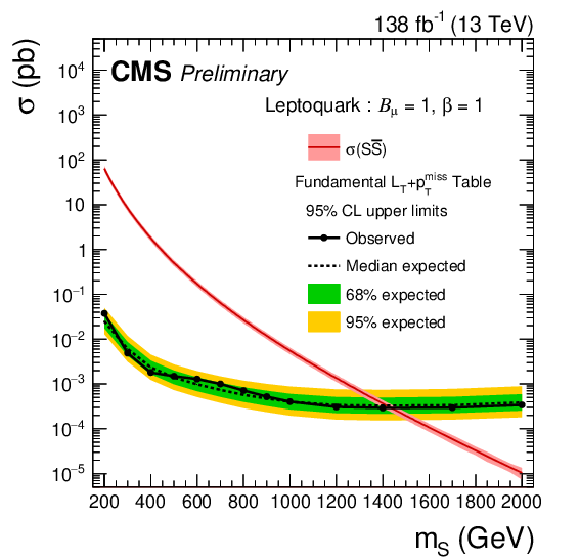
png pdf |
Additional Figure 50:
Observed and expected upper limits at 95% CL on the production cross section for the scalar leptoquarks with $\mathcal {B}_{{\mu}}=$ 1 coupling using the fundamental $L_{\rm T}+ {{p_{\mathrm {T}}} ^\text {miss}} $ table scheme. |
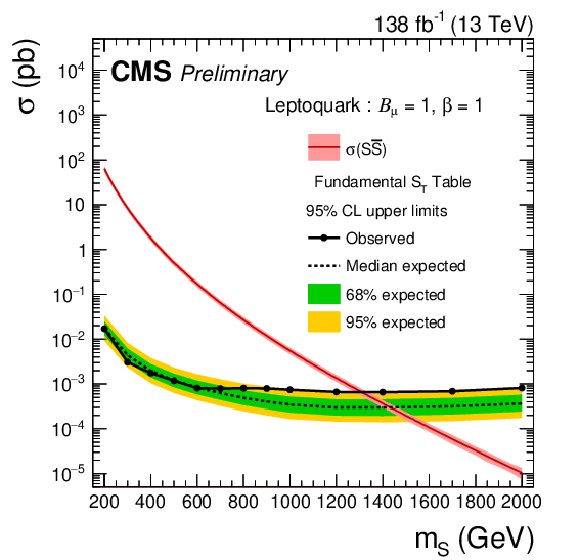
png pdf |
Additional Figure 51:
Observed and expected upper limits at 95% CL on the production cross section for the scalar leptoquarks with $\mathcal {B}_{{\mu}}=$ 1 coupling using the fundamental $S_{\rm T}$ table scheme. |

png pdf |
Additional Figure 52:
Observed and expected upper limits at 95% CL on the production cross section for the scalar leptoquarks with $\mathcal {B}_{{\mu}}=$ 1 coupling using the advanced $S_{\rm T}$ table scheme. |
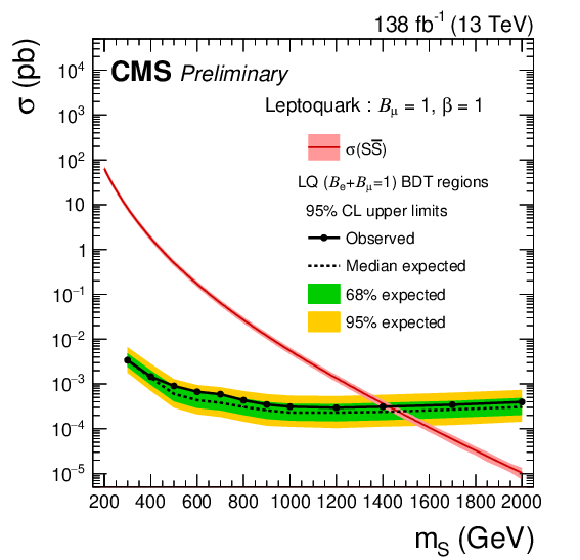
png pdf |
Additional Figure 53:
Observed and expected upper limits at 95% CL on the production cross section for the scalar leptoquarks with $\mathcal {B}_{{\mu}}=$ 1 coupling using the LQ ($\mathcal {B}_{{\mathrm {e}}}+\mathcal {B}_{{\mu}}=$ 1) regions. |
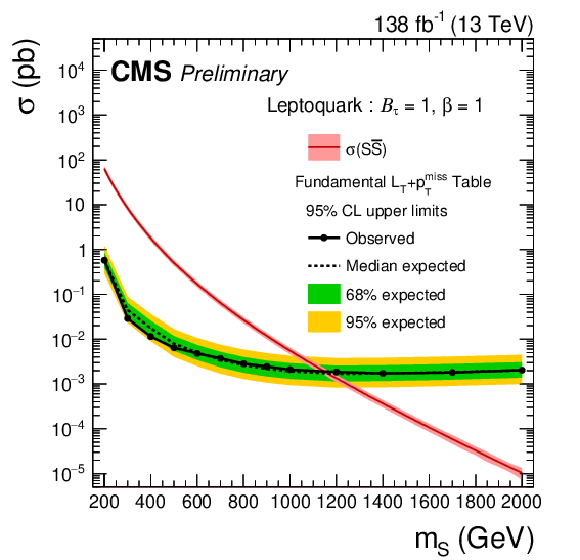
png pdf |
Additional Figure 54:
Observed and expected upper limits at 95% CL on the production cross section for the scalar leptoquarks with $\mathcal {B}_{{\tau}}=$ 1 coupling using the fundamental $L_{\rm T}+ {{p_{\mathrm {T}}} ^\text {miss}} $ table scheme. |
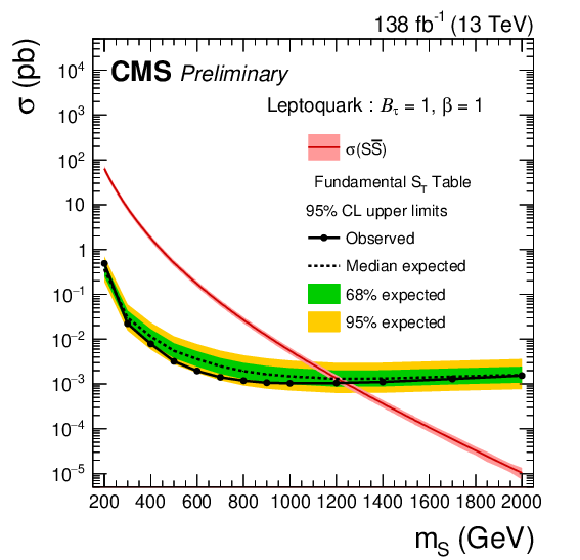
png pdf |
Additional Figure 55:
Observed and expected upper limits at 95% CL on the production cross section for the scalar leptoquarks with $\mathcal {B}_{{\tau}}=$ 1 coupling using the fundamental $S_{\rm T}$ table scheme. |
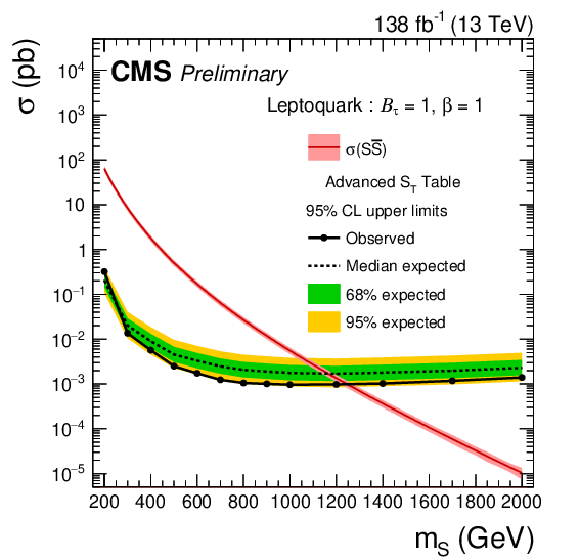
png pdf |
Additional Figure 56:
Observed and expected upper limits at 95% CL on the production cross section for the scalar leptoquarks with $\mathcal {B}_{{\tau}}=$ 1 coupling using the advanced $S_{\rm T}$ table scheme. |

png pdf |
Additional Figure 57:
Observed and expected upper limits at 95% CL on the production cross section for the scalar leptoquarks with $\mathcal {B}_{{\tau}}=$ 1 coupling using the LQ ($\mathcal {B}_{{\tau}}=$ 1) regions. |
| References | ||||
| 1 | P. Minkowski | $ \mu \to \mathrm{e}\gamma $ at a Rate of One Out of $ 10^{9} $ Muon Decays? | PLB 67 (1977) 421 | |
| 2 | R. N. Mohapatra and G. Senjanović | Neutrino Mass and Spontaneous Parity Nonconservation | PRL 44 (1980) 912 | |
| 3 | M. Magg and C. Wetterich | Neutrino Mass Problem and Gauge Hierarchy | PLB 94 (1980) 61 | |
| 4 | R. N. Mohapatra and G. Senjanović | Neutrino Masses and Mixings in Gauge Models with Spontaneous Parity Violation | PRD 23 (1981) 165 | |
| 5 | J. Schechter and J. W. F. Valle | Neutrino Masses in SU(2) x U(1) Theories | PRD 22 (1980) 2227 | |
| 6 | J. Schechter and J. W. F. Valle | Neutrino Decay and Spontaneous Violation of Lepton Number | PRD 25 (1982) 774 | |
| 7 | R. Foot, H. Lew, X. G. He, and G. C. Joshi | Seesaw Neutrino Masses Induced by a Triplet of Leptons | Z. Phys. C 44 (1989) 441 | |
| 8 | R. N. Mohapatra | Mechanism for Understanding Small Neutrino Mass in Superstring Theories | PRL 56 (1986) 561 | |
| 9 | R. N. Mohapatra and J. W. F. Valle | Neutrino Mass and Baryon Number Nonconservation in Superstring Models | PRD 34 (1986) 1642 | |
| 10 | C. Biggio and F. Bonnet | Implementation of the type-III Seesaw Model in FeynRules/MadGraph and Prospects for Discovery with Early LHC Data | EPJC 72 (2012) 1899 | 1107.3463 |
| 11 | C. Biggio et al. | Global Bounds on the Type-III Seesaw | JHEP 05 (2020) 022 | 1911.11790 |
| 12 | A. Das and S. Mandal | Bounds on the triplet fermions in type-III seesaw and implications for collider searches | NPB 966 (2021) 115374 | 2006.04123 |
| 13 | A. Abada et al. | Low energy effects of neutrino masses | JHEP 12 (2007) 061 | 0707.4058 |
| 14 | A. Abada et al. | $ \mu \to \mathrm{e}\gamma $ and $ \tau\to\ell\gamma $ decays in the fermion triplet seesaw model | PRD 78 (2008) 033007 | 0803.0481 |
| 15 | R. Franceschini, T. Hambye, and A. Strumia | Type-III see-saw at LHC | PRD 78 (2008) 033002 | 0805.1613 |
| 16 | Y. Cai, T. Han, T. Li, and R. Ruiz | Lepton Number Violation: Seesaw Models and Their Collider Tests | Front. in Phys. 6 (2018) 40 | 1711.02180 |
| 17 | S. Ashanujjaman and K. Ghosh | Type-III see-saw: Phenomenological implications of the information lost in decoupling from high-energy to low-energy | PLB 819 (2021) 136403 | 2102.09536 |
| 18 | CMS Collaboration | Search for physics beyond the standard model in multilepton final states in proton-proton collisions at $ \sqrt{s} = $ 13 TeV | JHEP 03 (2020) 051 | CMS-EXO-19-002 1911.04968 |
| 19 | ATLAS Collaboration | Search for type-III seesaw heavy leptons in dilepton final states in $ pp $ collisions at $ \sqrt{s} = $ 13 TeV with the ATLAS detector | EPJC 81 (2021) 218 | 2008.07949 |
| 20 | F. del Aguila and M. J. Bowick | The Possibility of New Fermions With $ \Delta $ I = 0 Mass | NPB 224 (1983) 107 | |
| 21 | P. M. Fishbane, R. E. Norton, and M. J. Rivard | Experimental Implications of Heavy Isosinglet Quarks and Leptons | PRD 33 (1986) 2632 | |
| 22 | P. M. Fishbane and P. Q. Hung | Lepton Masses in a Dynamical Model of Family Symmetry | Z. Phys. C 38 (1988) 649 | |
| 23 | I. Montvay | Three Mirror Pairs of Fermion Families | PLB 205 (1988) 315 | |
| 24 | K. Fujikawa | A Vector - like extension of the standard model | Prog. Theor. Phys. 92 (1994) 1149 | hep-ph/9411258 |
| 25 | F. del Aguila, L. Ametller, G. L. Kane, and J. Vidal | Vector Like Fermion and Standard Higgs Production at Hadron Colliders | NPB 334 (1990) 1 | |
| 26 | F. del Aguila, J. de Blas, and M. PerÉz-Victoria | Effects of new leptons in Electroweak Precision Data | PRD 78 (2008) 013010 | 0803.4008 |
| 27 | S. P. Martin | Extra vector-like matter and the lightest Higgs scalar boson mass in low-energy supersymmetry | PRD 81 (2010) 035004 | 0910.2732 |
| 28 | P. W. Graham, A. Ismail, S. Rajendran, and P. Saraswat | A Little Solution to the Little Hierarchy Problem: A Vector-like Generation | PRD 81 (2010) 055016 | 0910.3020 |
| 29 | M. Endo, K. Hamaguchi, S. Iwamoto, and N. Yokozaki | Higgs Mass and Muon Anomalous Magnetic Moment in Supersymmetric Models with Vector-Like Matters | PRD 84 (2011) 075017 | 1108.3071 |
| 30 | S. Zheng | Minimal Vectorlike Model in Supersymmetric Unification | EPJC 80 (2020) 273 | 1904.10145 |
| 31 | K. Kong, S. C. Park, and T. G. Rizzo | A vector-like fourth generation with a discrete symmetry from Split-UED | JHEP 07 (2010) 059 | 1004.4635 |
| 32 | G.-Y. Huang, K. Kong, and S. C. Park | Bounds on the Fermion-Bulk Masses in Models with Universal Extra Dimensions | JHEP 06 (2012) 099 | 1204.0522 |
| 33 | R. Nevzorov | $ E_6 $ inspired supersymmetric models with exact custodial symmetry | PRD 87 (2013) 015029 | 1205.5967 |
| 34 | I. Dor\vsner, S. Fajfer, and I. Mustać | Light vector-like fermions in a minimal SU(5) setup | PRD 89 (2014) 115004 | 1401.6870 |
| 35 | A. Joglekar and J. L. Rosner | Searching for signatures of $ E_{\rm 6} $ | PRD 96 (2017) 015026 | 1607.06900 |
| 36 | P. Schwaller, T. M. P. Tait, and R. Vega-Morales | Dark Matter and Vectorlike Leptons from Gauged Lepton Number | PRD 88 (2013) 035001 | 1305.1108 |
| 37 | J. Halverson, N. Orlofsky, and A. Pierce | Vectorlike Leptons as the Tip of the Dark Matter Iceberg | PRD 90 (2014) 015002 | 1403.1592 |
| 38 | S. Bahrami et al. | Dark matter and collider studies in the left-right symmetric model with vectorlike leptons | PRD 95 (2017) 095024 | 1612.06334 |
| 39 | S. Bhattacharya, P. Ghosh, N. Sahoo, and N. Sahu | Mini Review on Vector-Like Leptonic Dark Matter, Neutrino Mass, and Collider Signatures | Front. in Phys. 7 (2019) 80 | 1812.06505 |
| 40 | K. Agashe, T. Okui, and R. Sundrum | A Common Origin for Neutrino Anarchy and Charged Hierarchies | PRL 102 (2009) 101801 | 0810.1277 |
| 41 | M. Redi | Leptons in Composite MFV | JHEP 09 (2013) 060 | 1306.1525 |
| 42 | A. Falkowski, D. M. Straub, and A. Vicente | Vector-like leptons: Higgs decays and collider phenomenology | JHEP 05 (2014) 092 | 1312.5329 |
| 43 | R. Derm\'i\vsek and A. Raval | Explanation of the Muon g-2 Anomaly with Vectorlike Leptons and its Implications for Higgs Decays | PRD 88 (2013) 013017 | 1305.3522 |
| 44 | E. Megias, M. Quiros, and L. Salas | Muon g-2 from Vector-Like Leptons in Warped Space | JHEP 05 (2017) 016 | 1701.05072 |
| 45 | J. Kawamura, S. Raby, and A. Trautner | Complete vectorlike fourth family and new $ U(1)^{\prime} $ for muon anomalies | PRD 100 (2019) 055030 | 1906.11297 |
| 46 | G. Hiller, C. Hormigos-Feliu, D. F. Litim, and T. Steudtner | Model Building from Asymptotic Safety with Higgs and Flavor Portals | PRD 102 (2020) 095023 | 2008.08606 |
| 47 | Muon g-2 Collaboration | Final Report of the Muon E821 Anomalous Magnetic Moment Measurement at BNL | PRD 73 (2006) 072003 | hep-ex/0602035 |
| 48 | Muon g-2 Collaboration | Measurement of the Positive Muon Anomalous Magnetic Moment to 0.46 ppm | PRL 126 (2021) 141801 | 2104.03281 |
| 49 | N. Kumar and S. P. Martin | Vectorlike Leptons at the Large Hadron Collider | PRD 92 (2015) 115018 | 1510.03456 |
| 50 | P. N. Bhattiprolu and S. P. Martin | Prospects for vectorlike leptons at future proton-proton colliders | PRD 100 (2019) 015033 | 1905.00498 |
| 51 | R. Derm\'i\vsek, A. Raval, and S. Shin | Effects of vectorlike leptons on $ h\to 4\ell $ and the connection to the muon g-2 anomaly | PRD 90 (2014) 034023 | 1406.7018 |
| 52 | R. Derm\'i\vsek, J. P. Hall, E. Lunghi, and S. Shin | Limits on Vectorlike Leptons from Searches for Anomalous Production of Multi-Lepton Events | JHEP 12 (2014) 013 | 1408.3123 |
| 53 | CMS Collaboration | Search for vector-like leptons in multilepton final states in proton-proton collisions at $ \sqrt{s} = $ 13 TeV | PRD 100 (2019) 052003 | CMS-EXO-18-005 1905.10853 |
| 54 | L3 Collaboration | Search for heavy neutral and charged leptons in $ e^{+} e^{-} $ annihilation at LEP | PLB 517 (2001) 75 | hep-ex/0107015 |
| 55 | W. Buchmuller, R. Ruckl, and D. Wyler | Leptoquarks in Lepton - Quark Collisions | PLB 191 (1987) 442 | |
| 56 | J. C. Pati and A. Salam | Lepton Number as the Fourth Color | PRD 10 (1974) 275 | |
| 57 | H. Georgi and S. L. Glashow | Unity of All Elementary Particle Forces | PRL 32 (1974) 438 | |
| 58 | H. Fritzsch and P. Minkowski | Unified Interactions of Leptons and Hadrons | Annals Phys. 93 (1975) 193 | |
| 59 | B. Gripaios, M. Nardecchia, and S. A. Renner | Composite leptoquarks and anomalies in $ B $-meson decays | JHEP 05 (2015) 006 | 1412.1791 |
| 60 | L. Da Rold and F. Lamagna | Composite Higgs and leptoquarks from a simple group | JHEP 03 (2019) 135 | 1812.08678 |
| 61 | S. Weinberg | Supersymmetry at Ordinary Energies. 1. Masses and Conservation Laws | PRD 26 (1982) 287 | |
| 62 | R. Barbier et al. | R-parity violating supersymmetry | PR 420 (2005) 1 | hep-ph/0406039 |
| 63 | R. Mandal and A. Pich | Constraints on scalar leptoquarks from lepton and kaon physics | JHEP 12 (2019) 089 | 1908.11155 |
| 64 | B. Diaz, M. Schmaltz, and Y.-M. Zhong | The leptoquark Hunter's guide: Pair production | JHEP 10 (2017) 097 | 1706.05033 |
| 65 | S. Davidson and P. Verdier | Leptoquarks decaying to a top quark and a charged lepton at hadron colliders | PRD 83 (2011) 115016 | 1102.4562 |
| 66 | J. K. Mizukoshi, O. J. P. Éboli, and M. C. Gonzalez-Garcia | Bounds on scalar leptoquarks from $ Z $ physics | NPB 443 (1995) 20 | hep-ph/9411392 |
| 67 | E. Alvarez et al. | A composite pNGB leptoquark at the LHC | JHEP 12 (2018) 027 | 1808.02063 |
| 68 | A. Angelescu, D. Bečirević, D. A. Faroughy, and O. Sumensari | Closing the window on single leptoquark solutions to the $ B $-physics anomalies | JHEP 10 (2018) 183 | 1808.08179 |
| 69 | A. Crivellin, D. Muller, and F. Saturnino | Flavor Phenomenology of the Leptoquark Singlet-Triplet Model | JHEP 06 (2020) 020 | 1912.04224 |
| 70 | S. Saad and A. Thapa | Common origin of neutrino masses and $ R_{D^{(\ast)}} $, $ R_{K^{(\ast)}} $ anomalies | PRD 102 (2020) 015014 | 2004.07880 |
| 71 | U. Haisch and G. Polesello | Resonant third-generation leptoquark signatures at the Large Hadron Collider | JHEP 05 (2021) 057 | 2012.11474 |
| 72 | BaBar Collaboration | Measurement of an Excess of $ \bar{B} \to D^{(*)}\tau^- \bar{\nu}_\tau $ Decays and Implications for Charged Higgs Bosons | PRD 88 (2013) 072012 | 1303.0571 |
| 73 | Belle Collaboration | Measurement of $ \mathcal{R}(D) $ and $ \mathcal{R}(D^*) $ with a semileptonic tagging method | PRL 124 (2020) 161803 | 1910.05864 |
| 74 | LHCb Collaboration | Measurement of the ratio of branching fractions $ \mathcal{B}(B_c^+ \to J/\psi\tau^+\nu_\tau) $/$ \mathcal{B}(B_c^+ \to J/\psi\mu^+\nu_\mu) $ | PRL 120 (2018) 121801 | 1711.05623 |
| 75 | LHCb Collaboration | Measurement of the ratio of the $ B^0 \to D^{*-} \tau^+ \nu_{\tau} $ and $ B^0 \to D^{*-} \mu^+ \nu_{\mu} $ branching fractions using three-prong $ \tau $-lepton decays | PRL 120 (2018) 171802 | 1708.08856 |
| 76 | Belle Collaboration | Lepton-Flavor-Dependent Angular Analysis of $ B\to K^\ast \ell^+\ell^- $ | PRL 118 (2017) 111801 | 1612.05014 |
| 77 | LHCb Collaboration | Test of lepton universality with $ B^{0} \rightarrow K^{*0}\ell^{+}\ell^{-} $ decays | JHEP 08 (2017) 055 | 1705.05802 |
| 78 | LHCb Collaboration | Search for lepton-universality violation in $ B^+\to K^+\ell^+\ell^- $ decays | PRL 122 (2019) 191801 | 1903.09252 |
| 79 | ATLAS Collaboration | Search for pair production of scalar leptoquarks decaying into first- or second-generation leptons and top quarks in proton-proton collisions at $ \sqrt{s} = $ 13 TeV with the ATLAS detector | EPJC 81 (2021) 313 | 2010.02098 |
| 80 | ATLAS Collaboration | Search for pair production of third-generation scalar leptoquarks decaying into a top quark and a $ \tau $-lepton in $ pp $ collisions at $ \sqrt{s}= $ 13 TeV with the ATLAS detector | JHEP 06 (2021) 179 | 2101.11582 |
| 81 | ATLAS Collaboration | Searches for third-generation scalar leptoquarks in $ \sqrt{s} = $ 13 TeV pp collisions with the ATLAS detector | JHEP 06 (2019) 144 | 1902.08103 |
| 82 | CMS Collaboration | Search for leptoquarks coupled to third-generation quarks in proton-proton collisions at $ \sqrt{s}= $ 13 TeV | PRL 121 (2018) 241802 | CMS-B2G-16-027 1809.05558 |
| 83 | CMS Collaboration | Search for third-generation scalar leptoquarks decaying to a top quark and a $ \tau $ lepton at $ \sqrt{s}= $ 13 TeV | EPJC 78 (2018) 707 | CMS-B2G-16-028 1803.02864 |
| 84 | CMS Collaboration | Search for singly and pair-produced leptoquarks coupling to third-generation fermions in proton-proton collisions at $ \sqrt{s} = $ 13 TeV | PLB 819 (2021) 136446 | CMS-EXO-19-015 2012.04178 |
| 85 | CMS Collaboration | Constraints on models of scalar and vector leptoquarks decaying to a quark and a neutrino at $ \sqrt{s}= $ 13 TeV | PRD 98 (2018) 032005 | CMS-SUS-18-001 1805.10228 |
| 86 | CMS Collaboration | Search for heavy neutrinos and third-generation leptoquarks in hadronic states of two $ \tau $ leptons and two jets in proton-proton collisions at $ \sqrt{s} = $ 13 TeV | JHEP 03 (2019) 170 | CMS-EXO-17-016 1811.00806 |
| 87 | CMS Collaboration | Search for a singly produced third-generation scalar leptoquark decaying to a $ \tau $ lepton and a bottom quark in proton-proton collisions at $ \sqrt{s} = $ 13 TeV | JHEP 07 (2018) 115 | CMS-EXO-17-029 1806.03472 |
| 88 | CMS Collaboration | The CMS experiment at the CERN LHC | JINST 3 (2008) S08004 | CMS-00-001 |
| 89 | CMS Collaboration | Performance of the CMS Level-1 trigger in proton-proton collisions at $ \sqrt{s} = $ 13 TeV | JINST 15 (2020) P10017 | CMS-TRG-17-001 2006.10165 |
| 90 | CMS Collaboration | The CMS trigger system | JINST 12 (2017) P01020 | CMS-TRG-12-001 1609.02366 |
| 91 | J. Alwall et al. | The automated computation of tree-level and next-to-leading order differential cross sections, and their matching to parton shower simulations | JHEP 07 (2014) 079 | 1405.0301 |
| 92 | P. Nason | A New method for combining NLO QCD with shower Monte Carlo algorithms | JHEP 11 (2004) 040 | hep-ph/0409146 |
| 93 | S. Frixione, P. Nason, and C. Oleari | Matching NLO QCD computations with Parton Shower simulations: the POWHEG method | JHEP 11 (2007) 070 | 0709.2092 |
| 94 | S. Alioli, P. Nason, C. Oleari, and E. Re | A general framework for implementing NLO calculations in shower Monte Carlo programs: the POWHEG BOX | JHEP 06 (2010) 043 | 1002.2581 |
| 95 | J. M. Campbell and R. K. Ellis | MCFM for the Tevatron and the LHC | NPB Proc. Suppl. 205-206 (2010) 10 | 1007.3492 |
| 96 | Y. Gao et al. | Spin determination of single-produced resonances at hadron colliders | PRD 81 (2010) 075022 | 1001.3396 |
| 97 | S. Bolognesi et al. | On the spin and parity of a single-produced resonance at the LHC | PRD 86 (2012) 095031 | 1208.4018 |
| 98 | I. Anderson et al. | Constraining anomalous HVV interactions at proton and lepton colliders | PRD 89 (2014) 035007 | 1309.4819 |
| 99 | A. V. Gritsan, R. Rontsch, M. Schulze, and M. Xiao | Constraining anomalous Higgs boson couplings to the heavy flavor fermions using matrix element techniques | PRD 94 (2016) 055023 | 1606.03107 |
| 100 | T. Sjostrand, S. Mrenna, and P. Z. Skands | A Brief Introduction to PYTHIA 8.1 | CPC 178 (2008) 852 | 0710.3820 |
| 101 | T. Sjostrand et al. | An Introduction to PYTHIA 8.2 | CPC 191 (2015) 159 | 1410.3012 |
| 102 | B. Fuks, M. Klasen, D. R. Lamprea, and M. Rothering | Gaugino production in proton-proton collisions at a center-of-mass energy of 8 TeV | JHEP 10 (2012) 081 | 1207.2159 |
| 103 | B. Fuks, M. Klasen, D. R. Lamprea, and M. Rothering | Precision predictions for electroweak superpartner production at hadron colliders with Resummino | EPJC 73 (2013) 2480 | 1304.0790 |
| 104 | J. Blumlein, E. Boos, and A. Kryukov | Leptoquark pair production in hadronic interactions | Z. Phys. C 76 (1997) 137 | hep-ph/9610408 |
| 105 | M. Kramer, T. Plehn, M. Spira, and P. M. Zerwas | Pair production of scalar leptoquarks at the CERN LHC | PRD 71 (2005) 057503 | hep-ph/0411038 |
| 106 | NNPDF Collaboration | Parton distributions for the LHC Run II | JHEP 04 (2015) 040 | 1410.8849 |
| 107 | NNPDF Collaboration | Parton distributions from high-precision collider data | EPJC 77 (2017) 663 | 1706.00428 |
| 108 | CMS Collaboration | Event generator tunes obtained from underlying event and multiparton scattering measurements | EPJC 76 (2016) 155 | CMS-GEN-14-001 1512.00815 |
| 109 | CMS Collaboration | Extraction and validation of a new set of CMS PYTHIA8 tunes from underlying-event measurements | EPJC 80 (2020) 4 | CMS-GEN-17-001 1903.12179 |
| 110 | R. Frederix and S. Frixione | Merging meets matching in MC@NLO | JHEP 12 (2012) 061 | 1209.6215 |
| 111 | S. Hoeche et al. | Matching Parton Showers and Matrix Elements | hep-ph/0602031 | |
| 112 | GEANT4 Collaboration | GEANT4--a simulation toolkit | NIMA 506 (2003) 250 | |
| 113 | M. Cacciari, G. P. Salam, and G. Soyez | The anti-$ {k_{\mathrm{T}}} $ jet clustering algorithm | JHEP 04 (2008) 063 | 0802.1189 |
| 114 | M. Cacciari, G. P. Salam, and G. Soyez | FastJet User Manual | EPJC 72 (2012) 1896 | 1111.6097 |
| 115 | CMS Collaboration | Particle-flow reconstruction and global event description with the CMS detector | JINST 12 (2017) P10003 | CMS-PRF-14-001 1706.04965 |
| 116 | CMS Collaboration | Performance of the CMS muon detector and muon reconstruction with proton-proton collisions at $ \sqrt{s}= $ 13 TeV | JINST 13 (2018) P06015 | CMS-MUO-16-001 1804.04528 |
| 117 | CMS Collaboration | Performance of Electron Reconstruction and Selection with the CMS Detector in Proton-Proton Collisions at $ \$ \sqrt{s} = $ $ 8 TeV | JINST 10 (2015) P06005 | CMS-EGM-13-001 1502.02701 |
| 118 | CMS Collaboration | Performance of reconstruction and identification of $ \tau $ leptons decaying to hadrons and $ \nu_\tau $ in pp collisions at $ \sqrt{s}= $ 13 TeV | JINST 13 (2018) P10005 | CMS-TAU-16-003 1809.02816 |
| 119 | M. Cacciari, G. P. Salam, and G. Soyez | The catchment area of jets | JHEP 04 (2008) 005 | 0802.1188 |
| 120 | M. Cacciari and G. P. Salam | Pileup subtraction using jet areas | PLB 659 (2008) 119 | 0707.1378 |
| 121 | CMS Collaboration | Jet energy scale and resolution in the CMS experiment in pp collisions at 8 TeV | JINST 12 (2017) P02014 | CMS-JME-13-004 1607.03663 |
| 122 | CMS Collaboration | Jet algorithms performance in 13 TeV data | CMS-PAS-JME-16-003 | CMS-PAS-JME-16-003 |
| 123 | CMS Collaboration | Identification of heavy-flavour jets with the CMS detector in pp collisions at 13 TeV | JINST 13 (2018) P05011 | CMS-BTV-16-002 1712.07158 |
| 124 | CMS Collaboration | Performance of missing transverse momentum reconstruction in proton-proton collisions at $ \sqrt{s} = $ 13 TeV using the CMS detector | JINST 14 (2019) P07004 | CMS-JME-17-001 1903.06078 |
| 125 | D. Bertolini, P. Harris, M. Low, and N. Tran | Pileup Per Particle Identification | JHEP 10 (2014) 059 | 1407.6013 |
| 126 | CMS Collaboration | Performance of the DeepTau algorithm for the discrimination of taus against jets, electron, and muons | CDS | |
| 127 | CMS Collaboration | Measurements of the $ \mathrm {p}\mathrm {p}\rightarrow \mathrm{Z}\mathrm{Z} $ production cross section and the $ \mathrm{Z}\rightarrow 4\ell $ branching fraction, and constraints on anomalous triple gauge couplings at $ \sqrt{s} = $ 13 TeV | EPJC 78 (2018) 165 | CMS-SMP-16-017 1709.08601 |
| 128 | CMS Collaboration | Measurements of the pp $ \to $ WZ inclusive and differential production cross section and constraints on charged anomalous triple gauge couplings at $ \sqrt{s} = $ 13 TeV | JHEP 04 (2019) 122 | CMS-SMP-18-002 1901.03428 |
| 129 | CMS Collaboration | Measurements of pp $ \to $ ZZ production cross sections and constraints on anomalous triple gauge couplings at $ \sqrt{s} = $ 13 TeV | EPJC 81 (2021) 200 | CMS-SMP-19-001 2009.01186 |
| 130 | ATLAS Collaboration | Measurement of $ W^{\pm}Z $ production cross sections and gauge boson polarisation in $ pp $ collisions at $ \sqrt{s} = $ 13 TeV with the ATLAS detector | EPJC 79 (2019) 535 | 1902.05759 |
| 131 | ATLAS Collaboration | $ ZZ \to \ell^{+}\ell^{-}\ell^{\prime +}\ell^{\prime -} $ cross-section measurements and search for anomalous triple gauge couplings in 13 $ TeV pp $ collisions with the ATLAS detector | PRD 97 (2018) 032005 | 1709.07703 |
| 132 | CMS Collaboration | Search for Third-Generation Scalar Leptoquarks in the t$ \tau $ Channel in Proton-Proton Collisions at $ \sqrt{s} = $ 8 TeV | JHEP 07 (2015) 042 | CMS-EXO-14-008 1503.09049 |
| 133 | CMS Collaboration | Measurement of the Inclusive $ W $ and $ Z $ Production Cross Sections in $ pp $ Collisions at $ \sqrt{s}= $ 7 TeV | JHEP 10 (2011) 132 | CMS-EWK-10-005 1107.4789 |
| 134 | Particle Data Group Collaboration | Review of Particle Physics | PTEP 2020 (8, 2020) 083C01 | |
| 135 | H. Voss, A. Hocker, J. Stelzer, and F. Tegenfeldt | TMVA, the Toolkit for Multivariate Data Analysis with ROOT | PoS ACAT (2007) 040 | physics/0703039v2 |
| 136 | M. Cacciari et al. | The $ t\bar{t} $ cross-section at 1.8 and 1.96 TeV: A study of the systematics due to parton densities and scale dependence | JHEP 04 (2004) 068 | hep-ph/0303085 |
| 137 | CMS Collaboration | CMS luminosity measurements for the 2016 data-taking period | CMS-PAS-LUM-17-001 | CMS-PAS-LUM-17-001 |
| 138 | CMS Collaboration | CMS luminosity measurement for the 2017 data-taking period at $ \sqrt{s} = $ 13 TeV | CMS-PAS-LUM-17-004 | CMS-PAS-LUM-17-004 |
| 139 | CMS Collaboration | CMS luminosity measurement for the 2018 data-taking period at $ \sqrt{s} = $ 13 TeV | CMS-PAS-LUM-18-002 | CMS-PAS-LUM-18-002 |
| 140 | S. Baker and R. D. Cousins | Clarification of the Use of Chi Square and Likelihood Functions in Fits to Histograms | NIM221 (1984) 437 | |
| 141 | E. Gross and O. Vitells | Trial factors for the look elsewhere effect in high energy physics | EPJC 70 (2010) 525 | 1005.1891 |
| 142 | T. Junk | Confidence level computation for combining searches with small statistics | NIMA 434 (1999) 435 | hep-ex/9902006 |
| 143 | A. L. Read | Presentation of search results: The $ CL_s $ technique | JPG 28 (2002) 2693 | |
| 144 | G. Cowan, K. Cranmer, E. Gross, and O. Vitells | Asymptotic formulae for likelihood-based tests of new physics | EPJC 71 (2011) 1554 | 1007.1727 |
| 145 | ATLAS, CMS, LHC Higgs Combination Group Collaboration | Procedure for the LHC Higgs boson search combination in Summer 2011 | CMS-NOTE-2011-005 | |

|
Compact Muon Solenoid LHC, CERN |

|

|

|

|

|

|